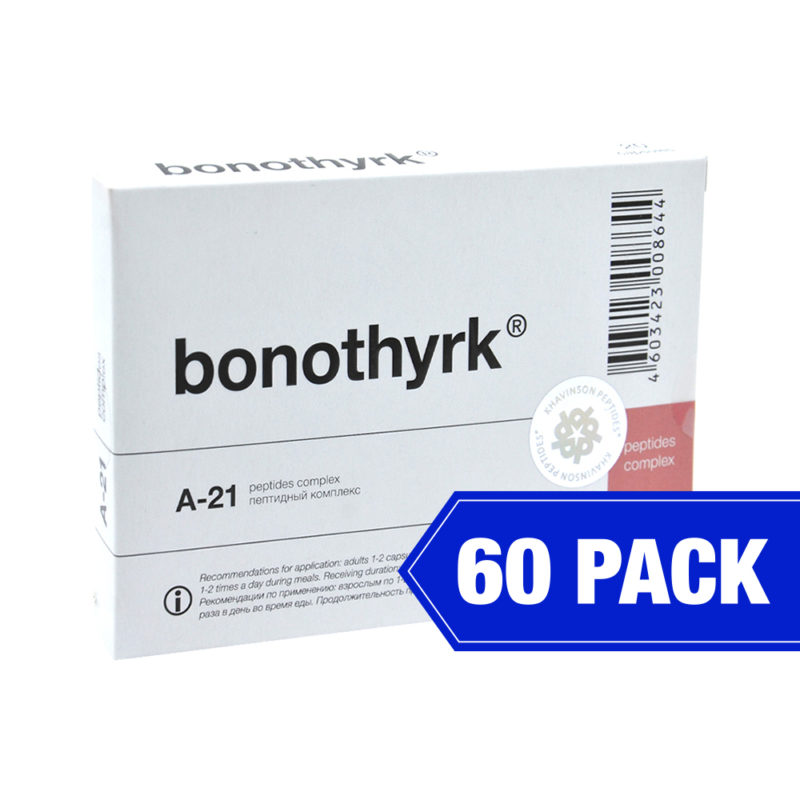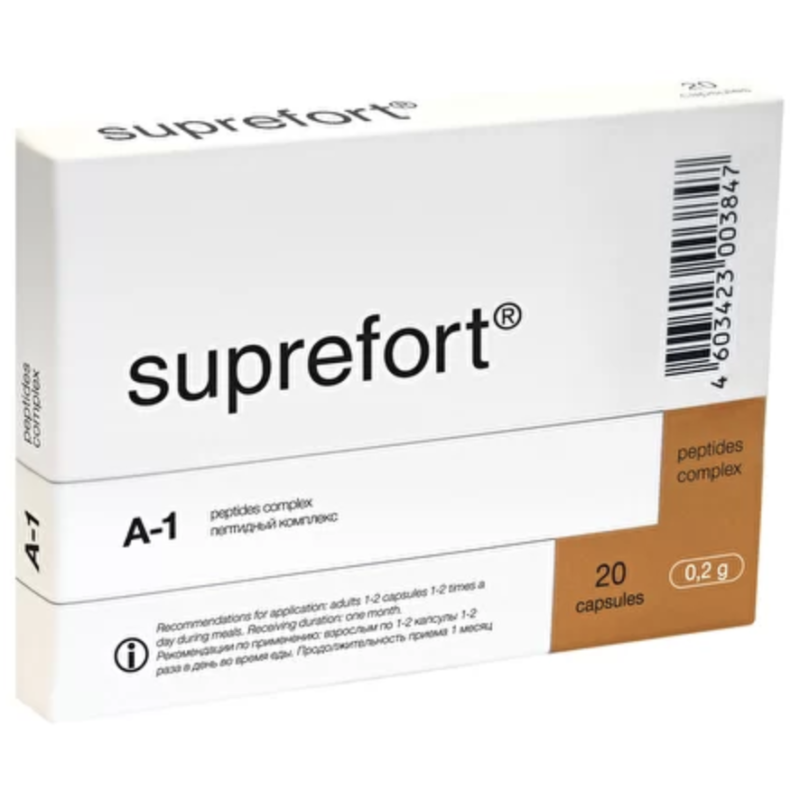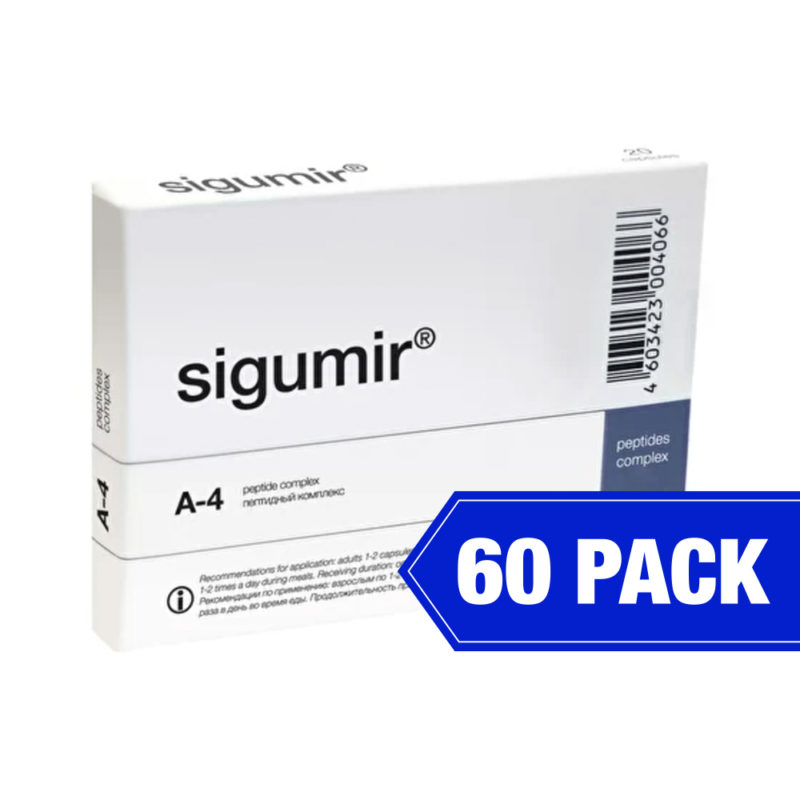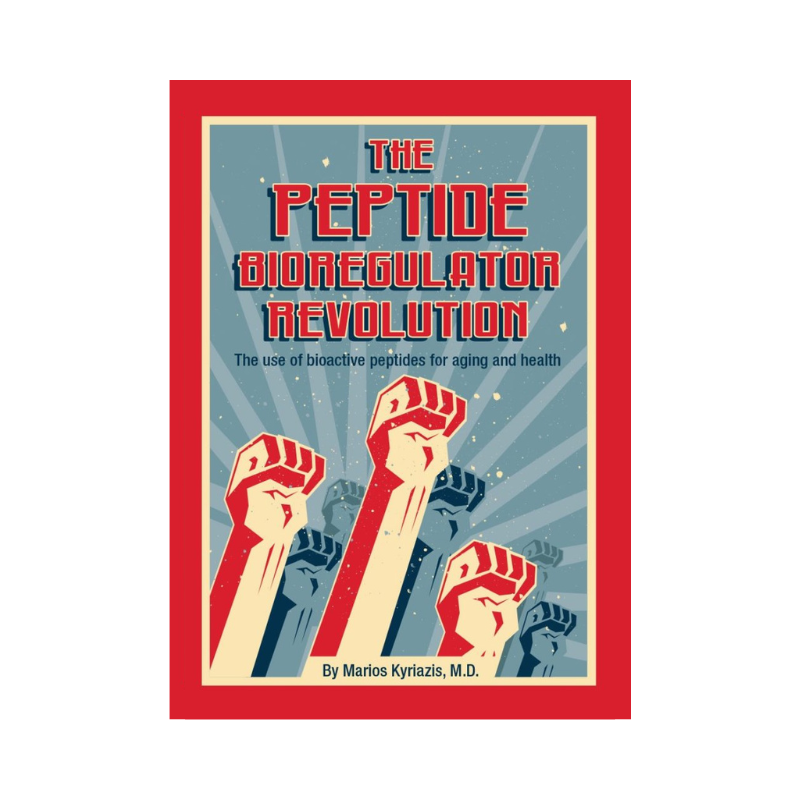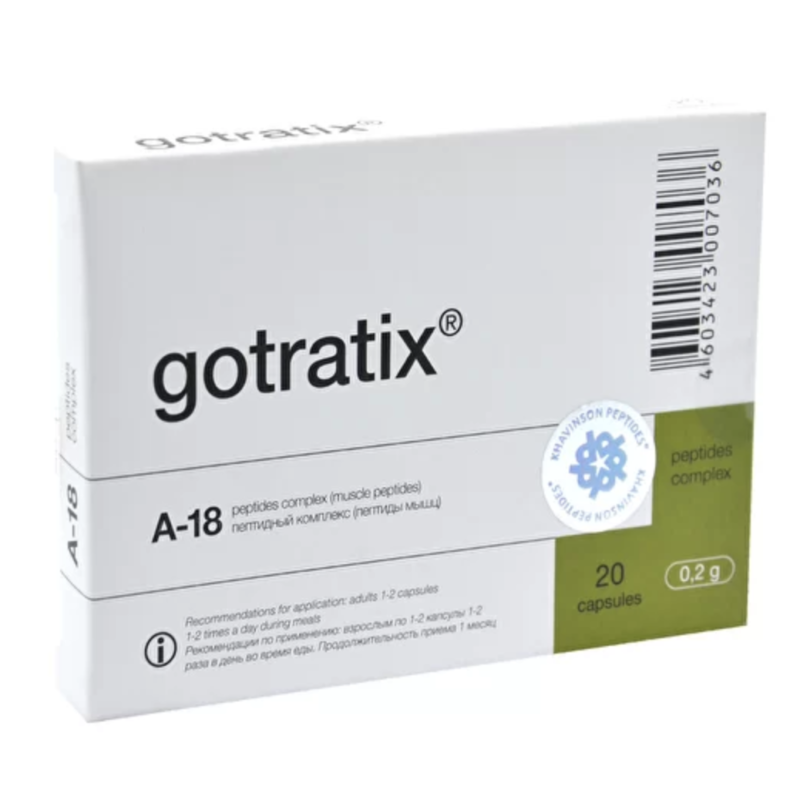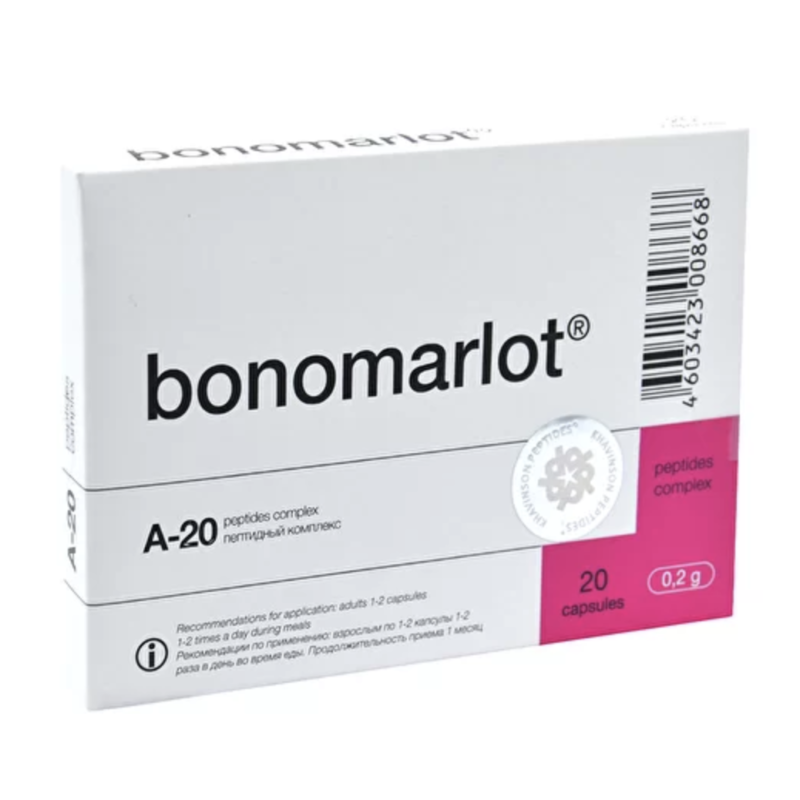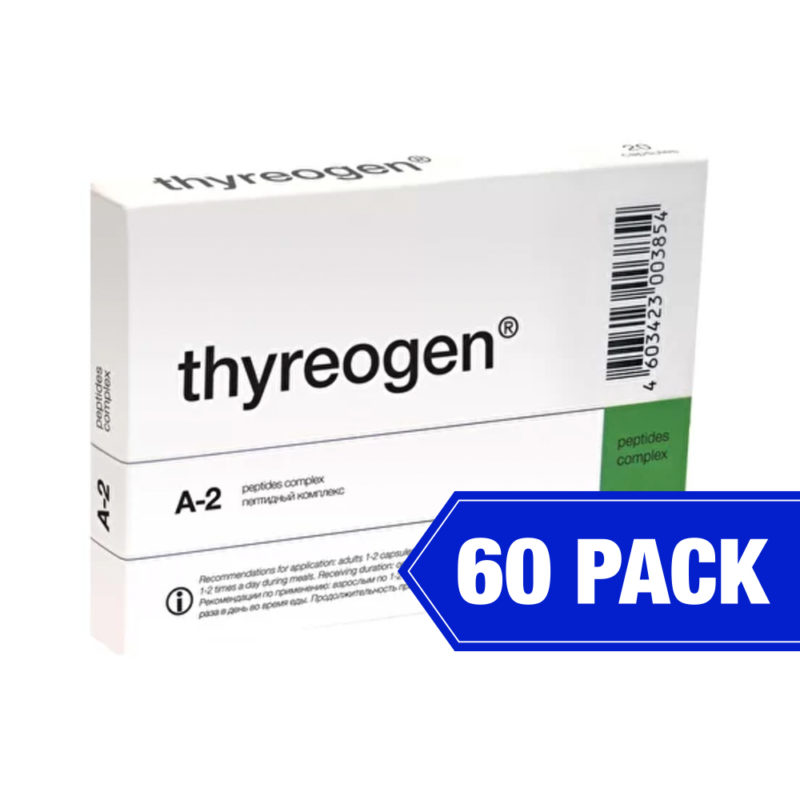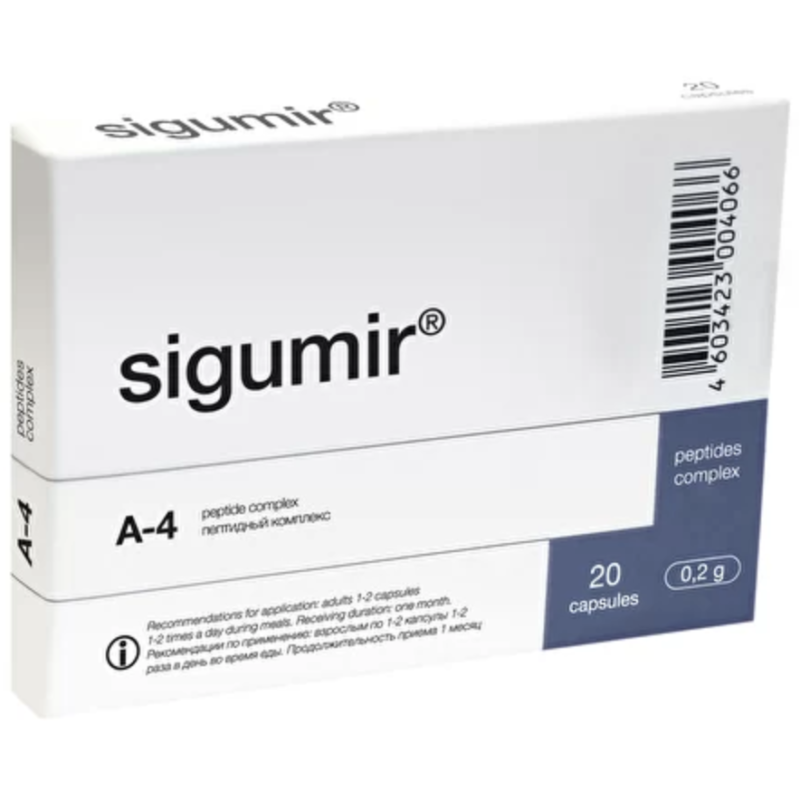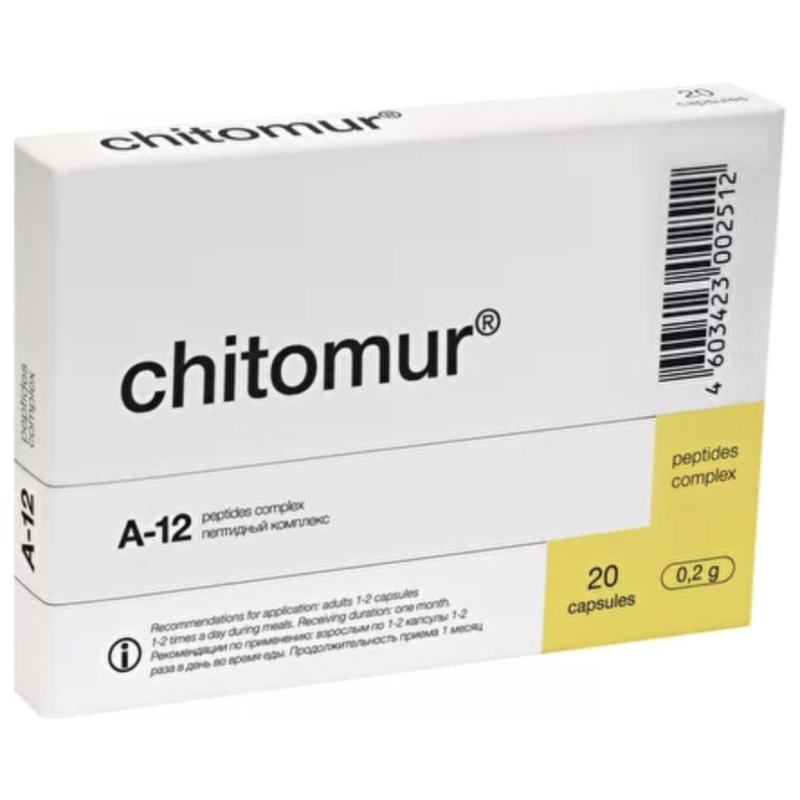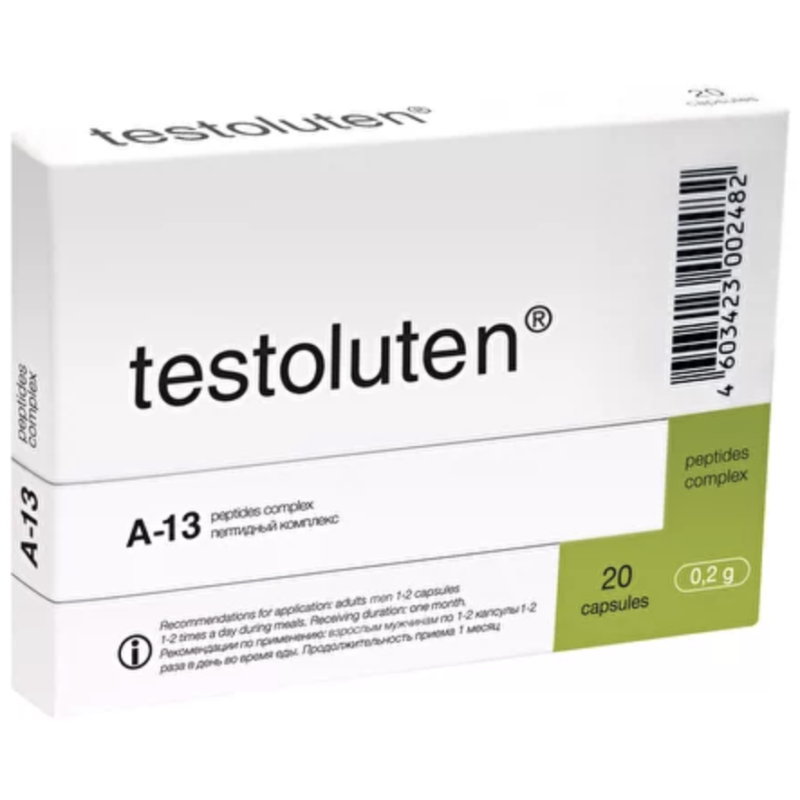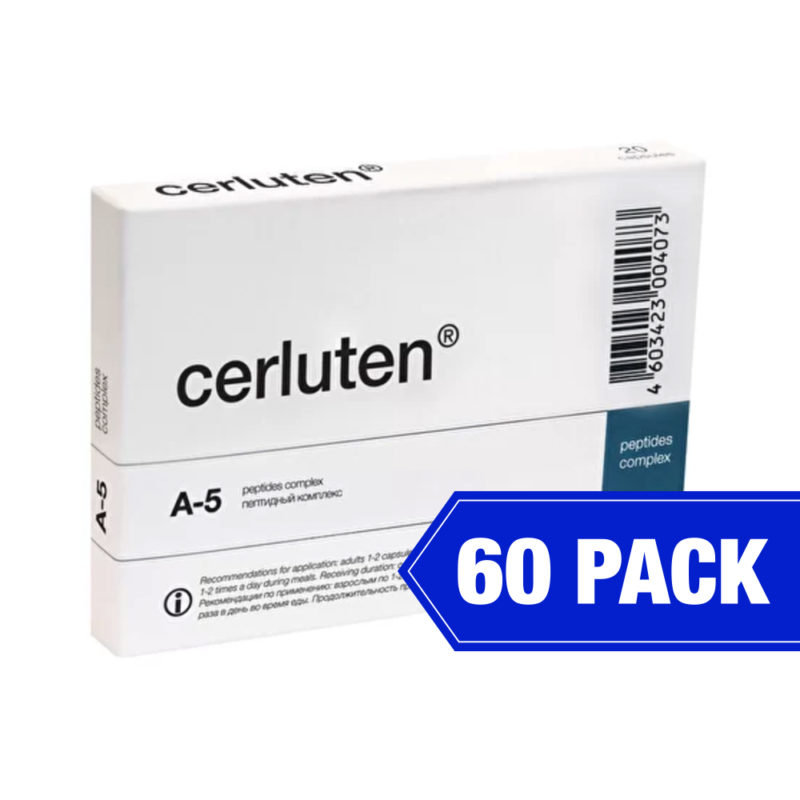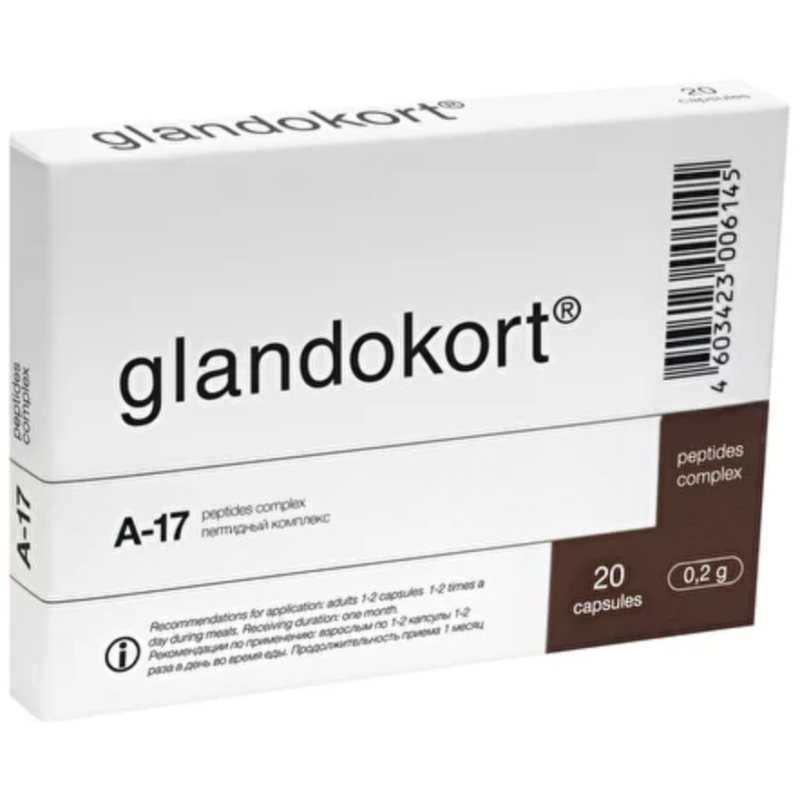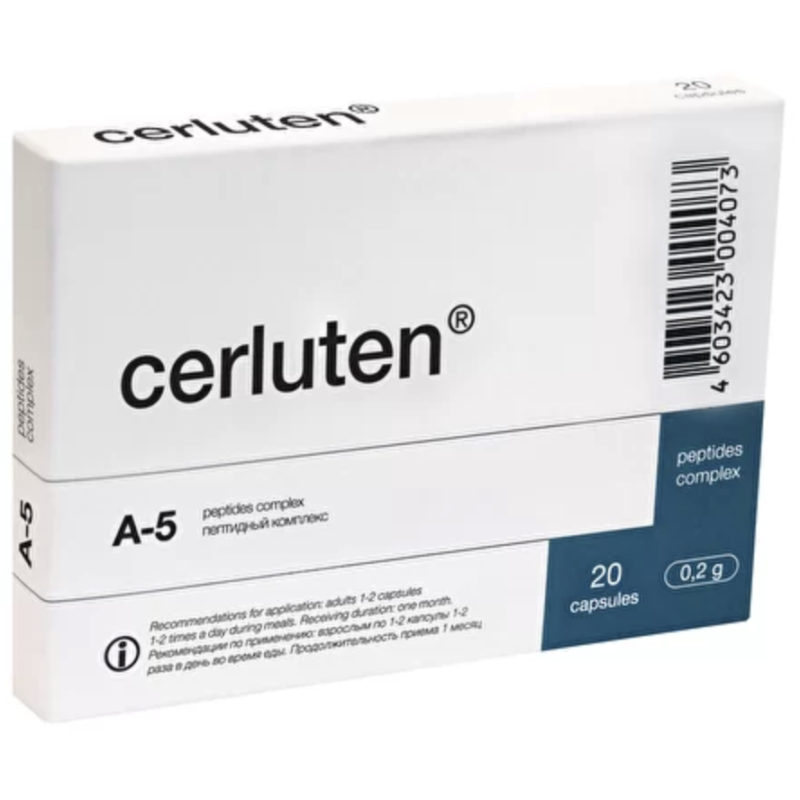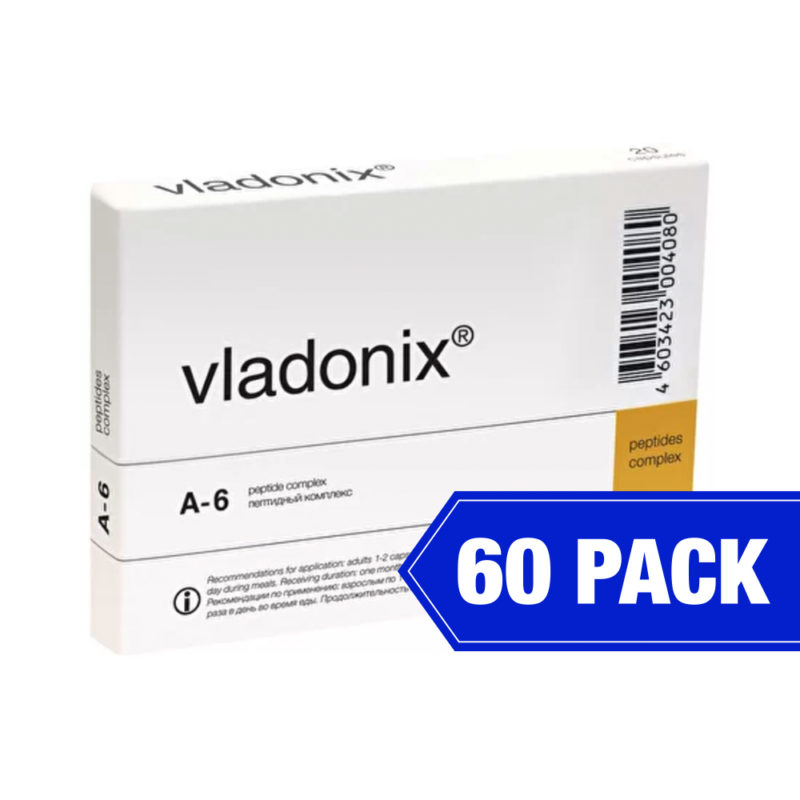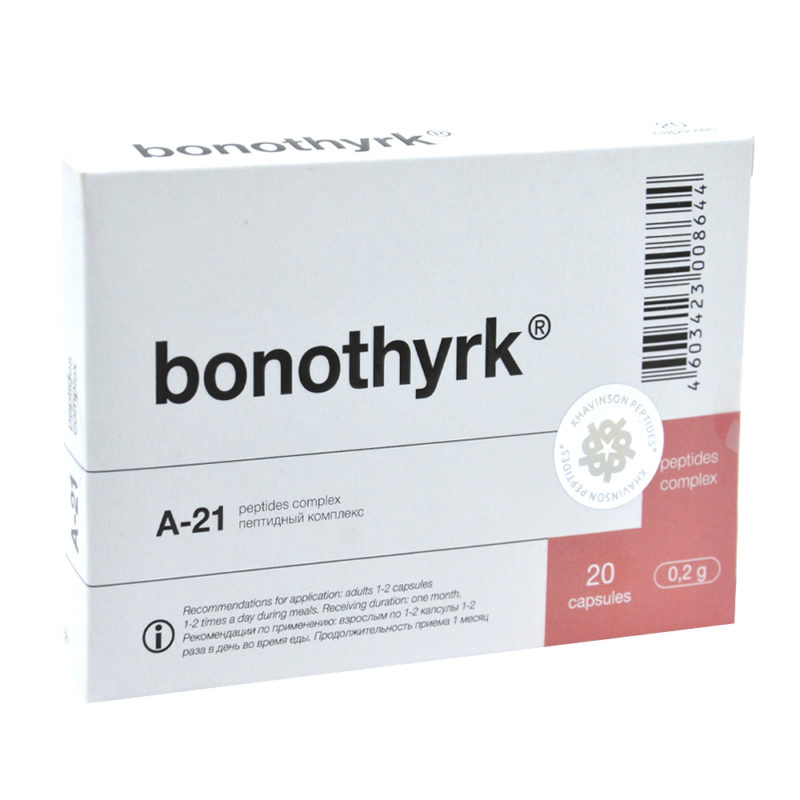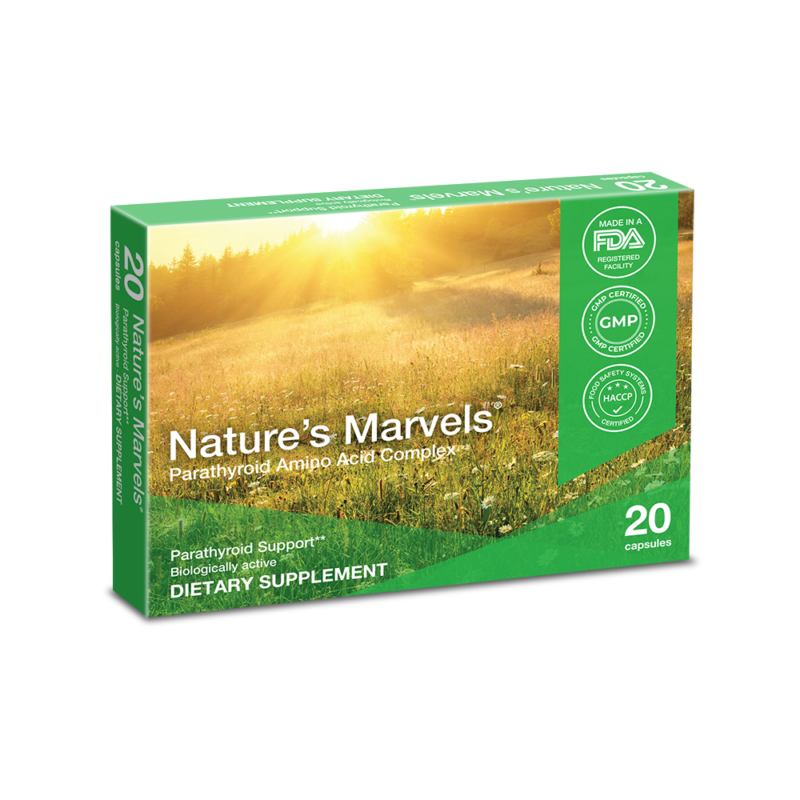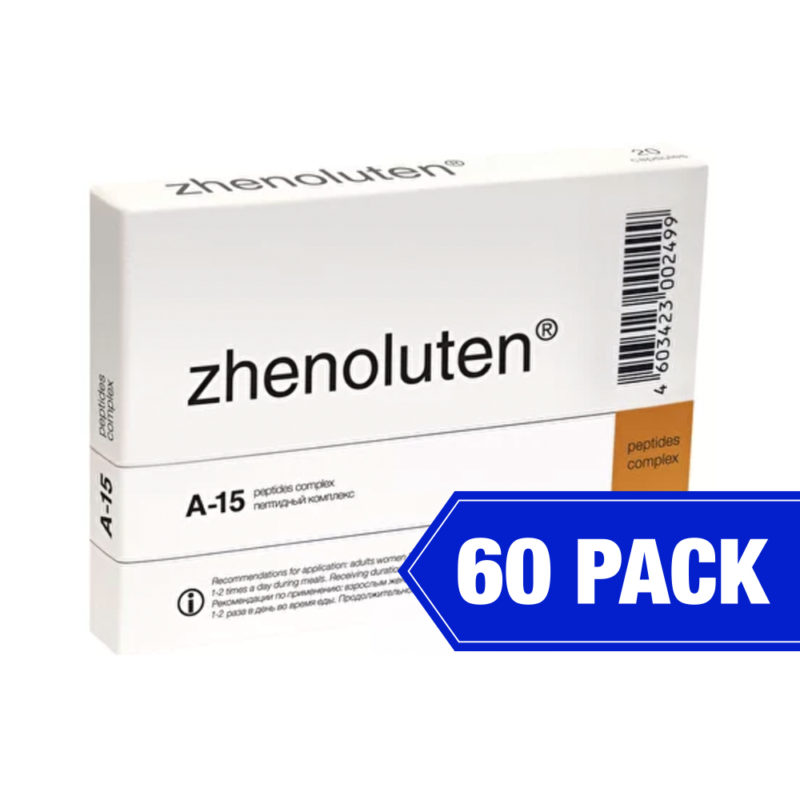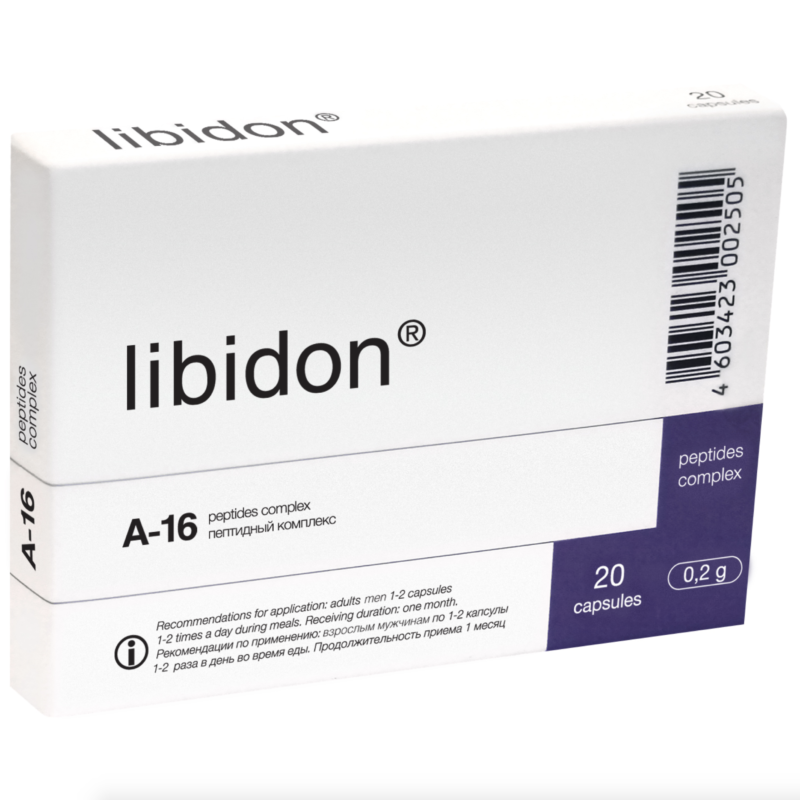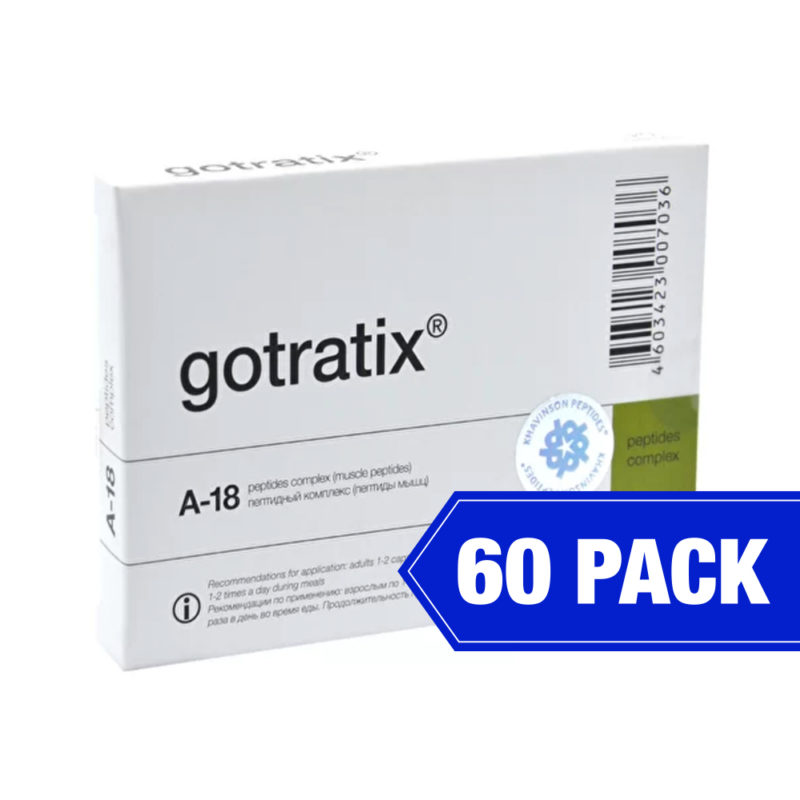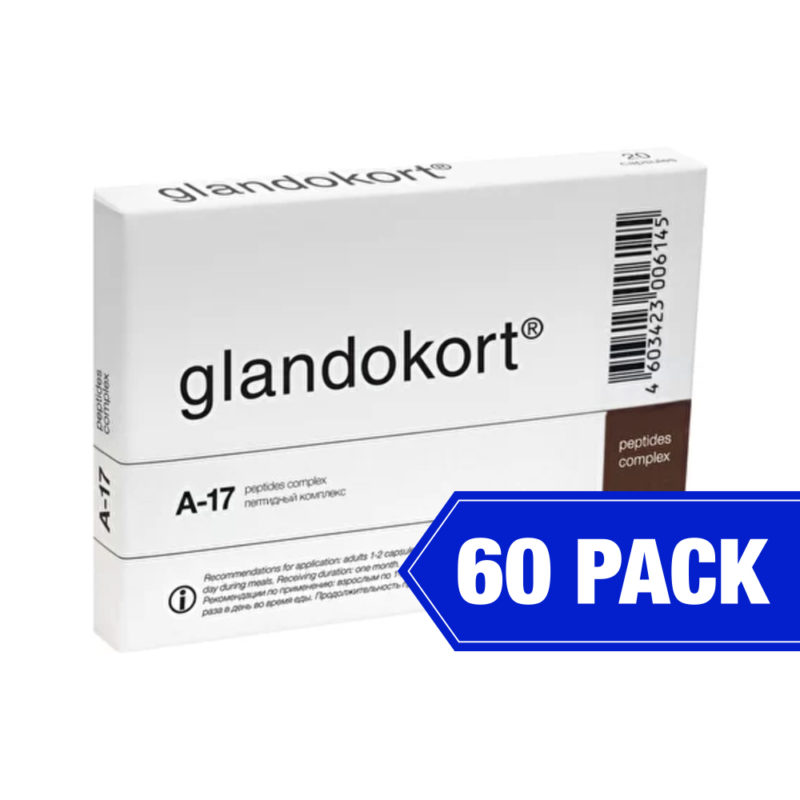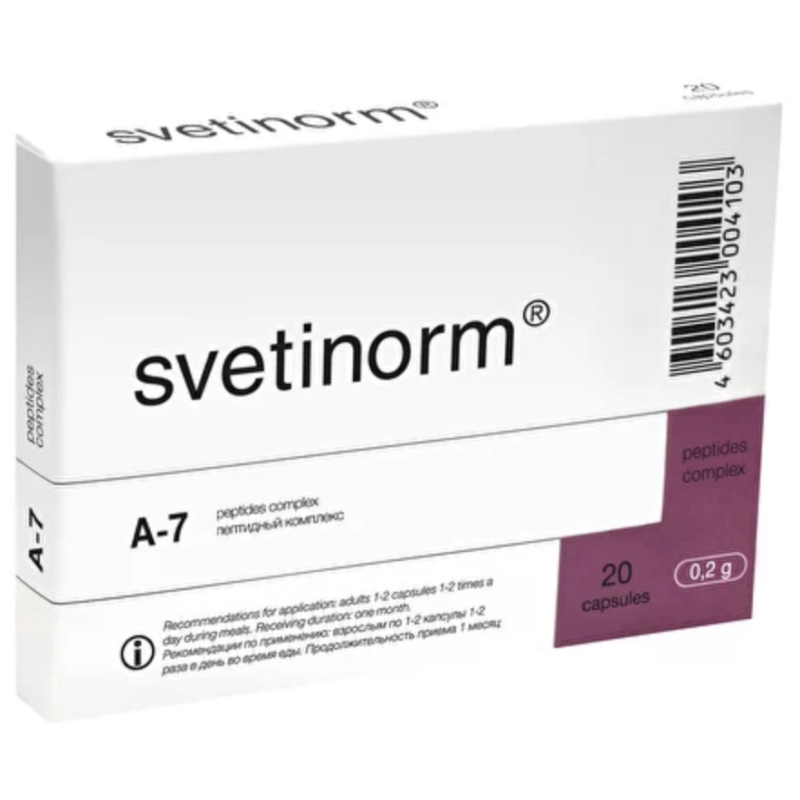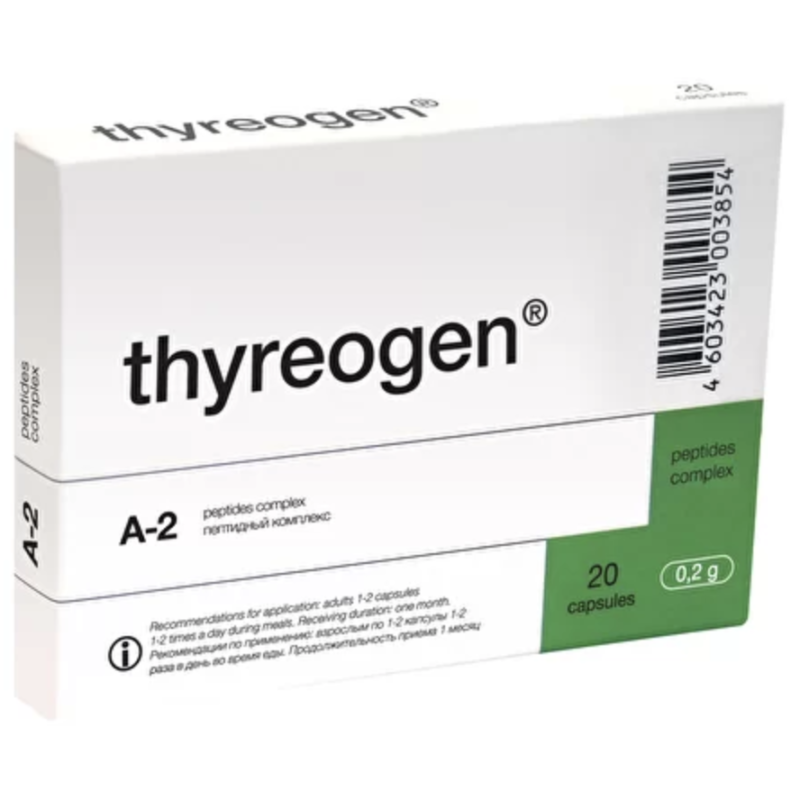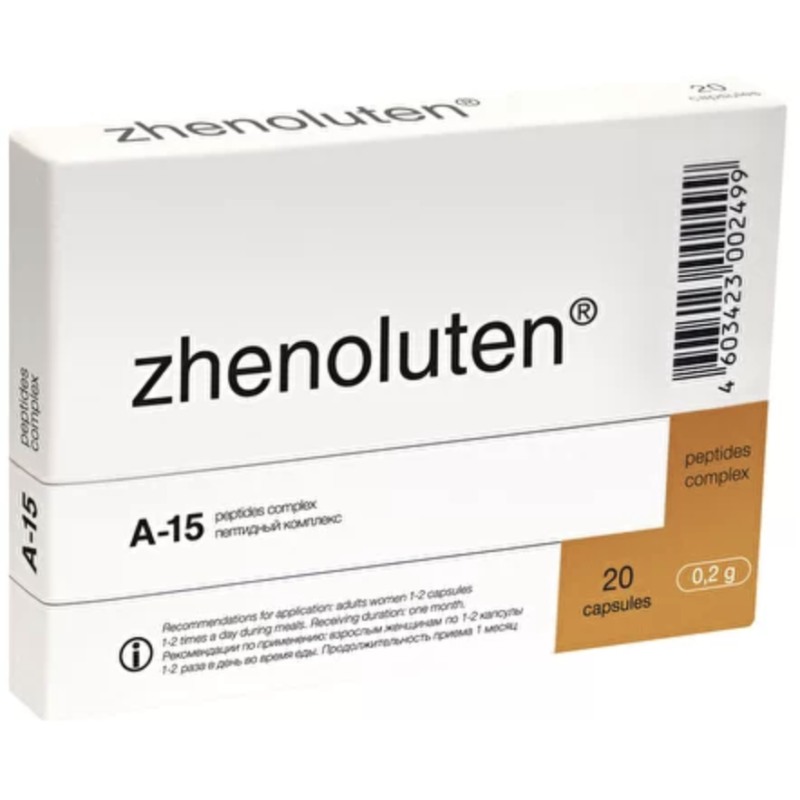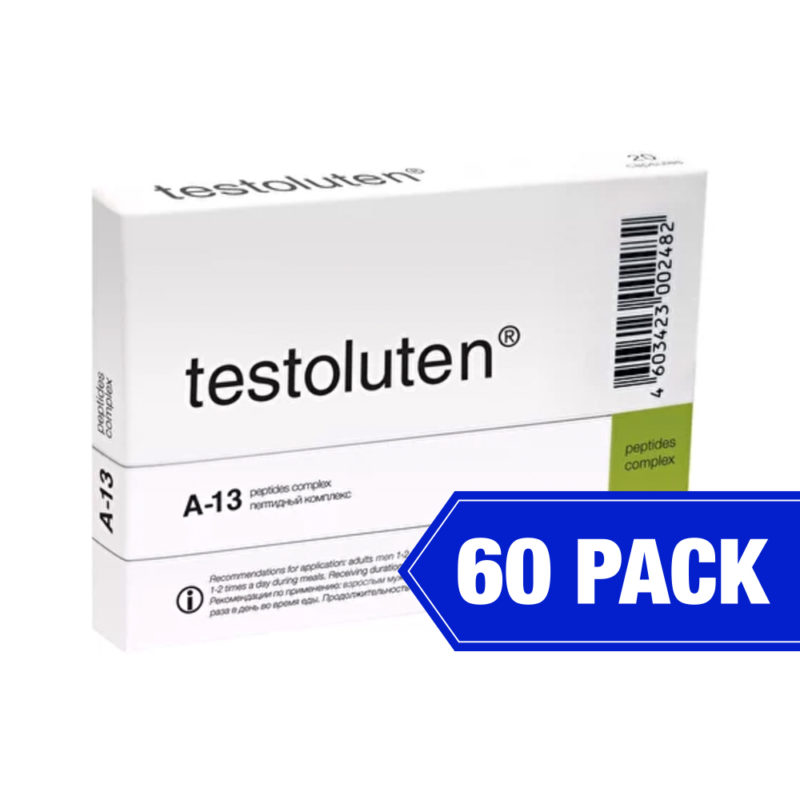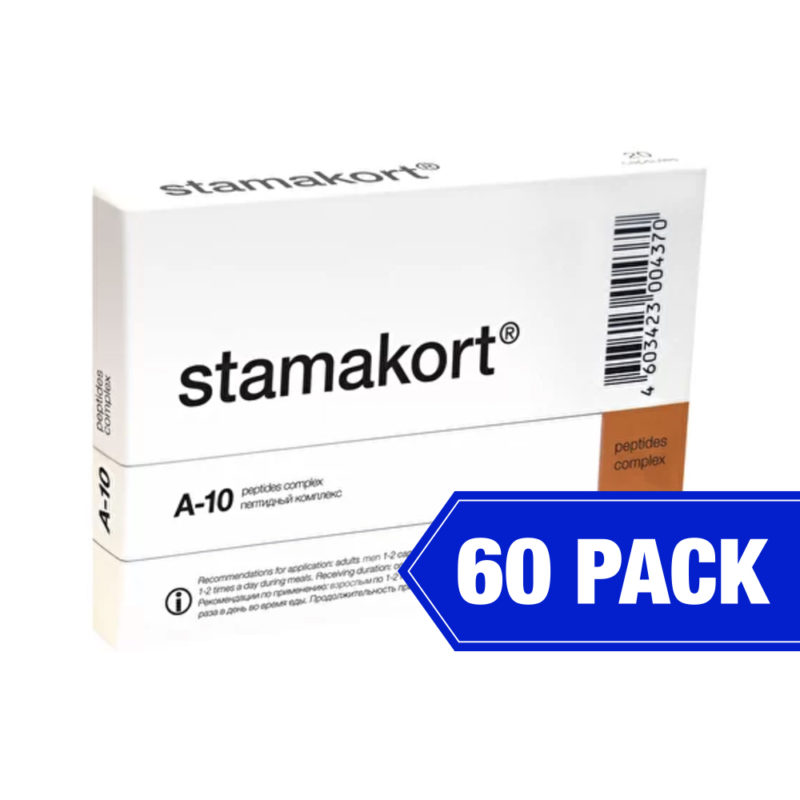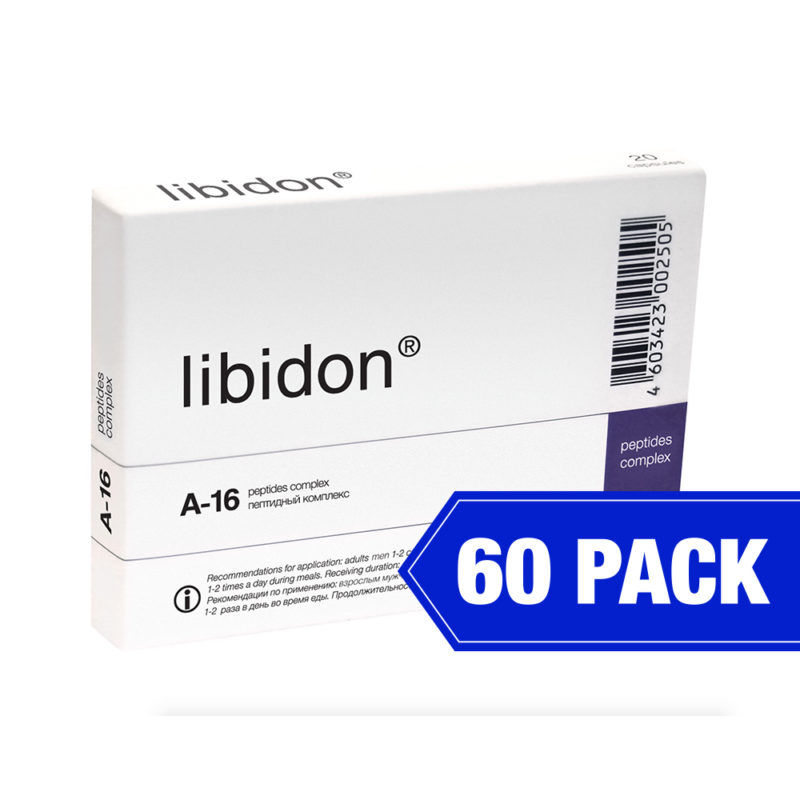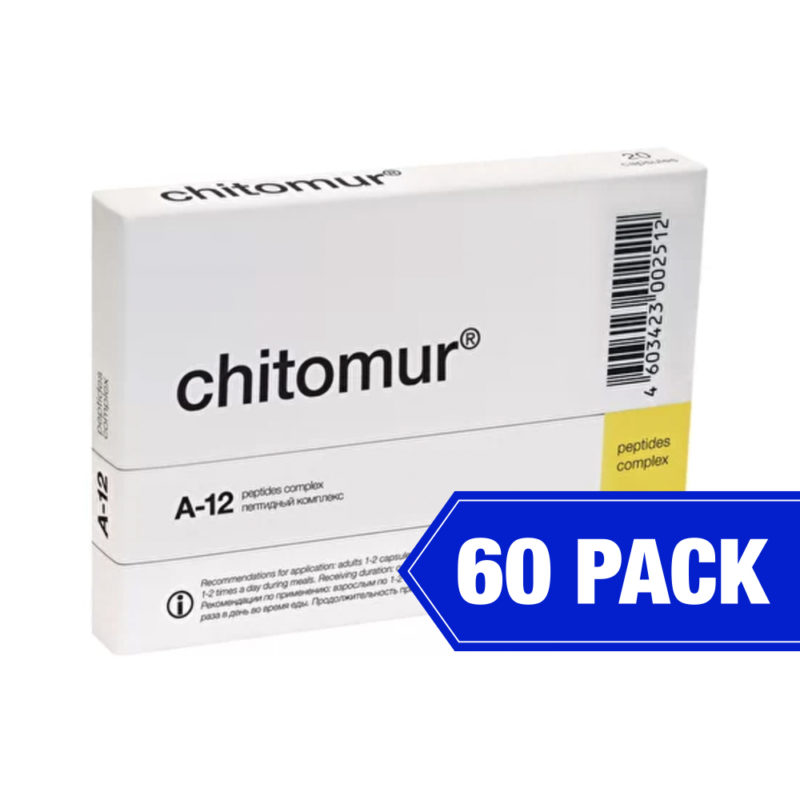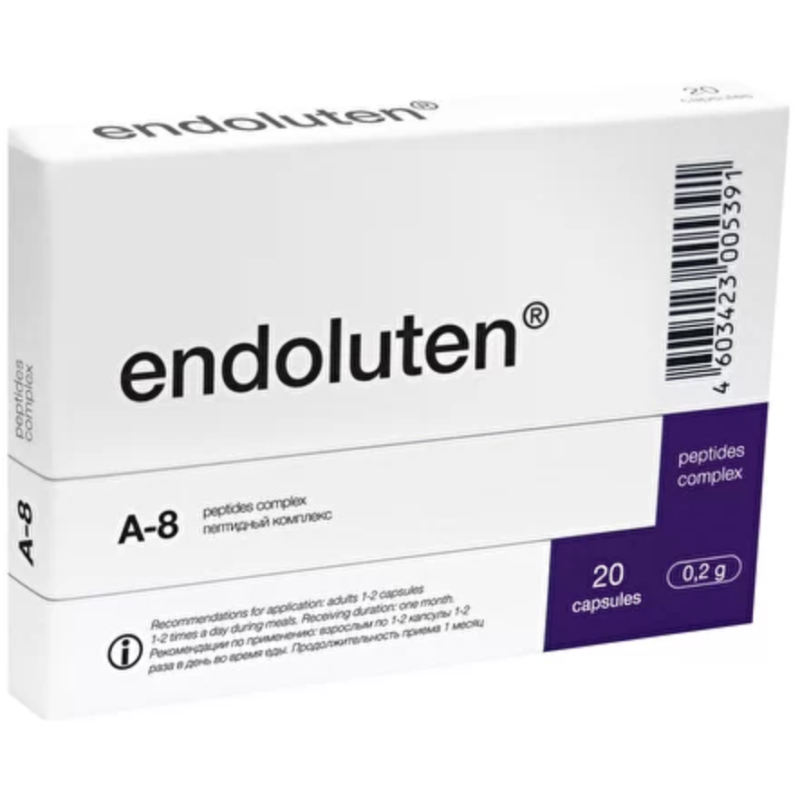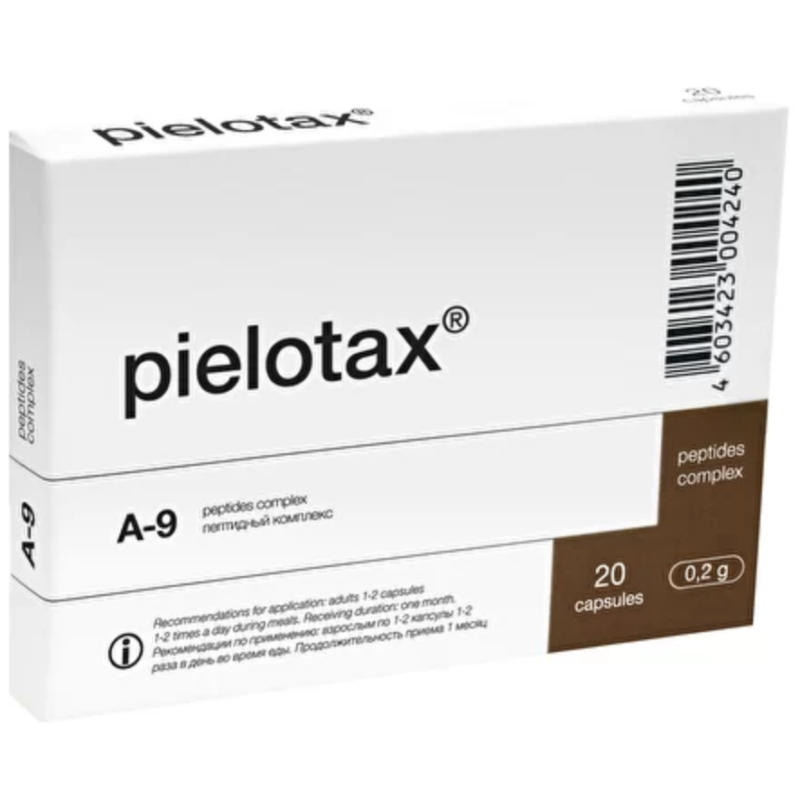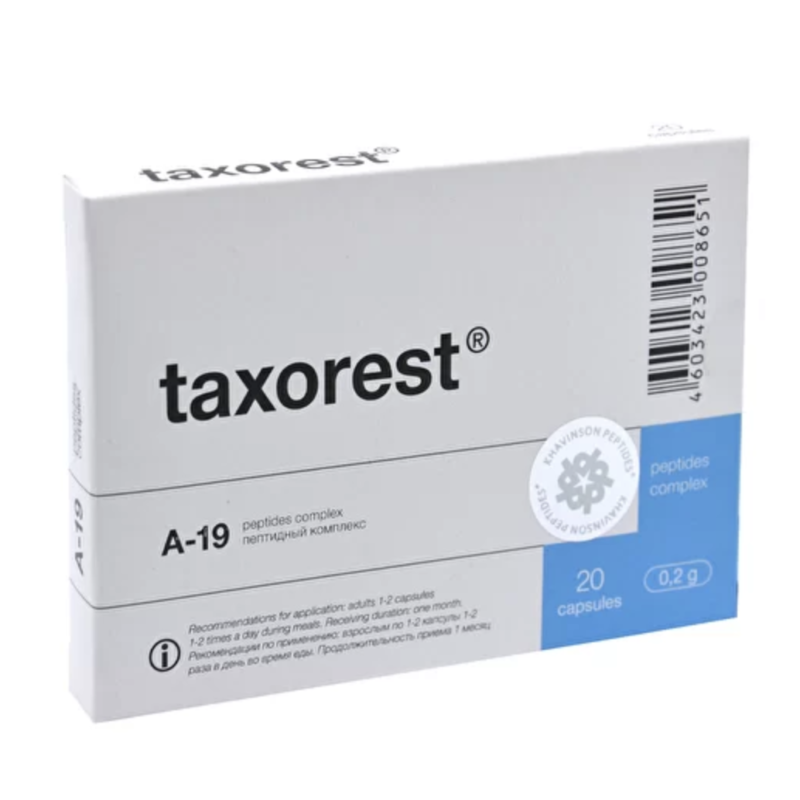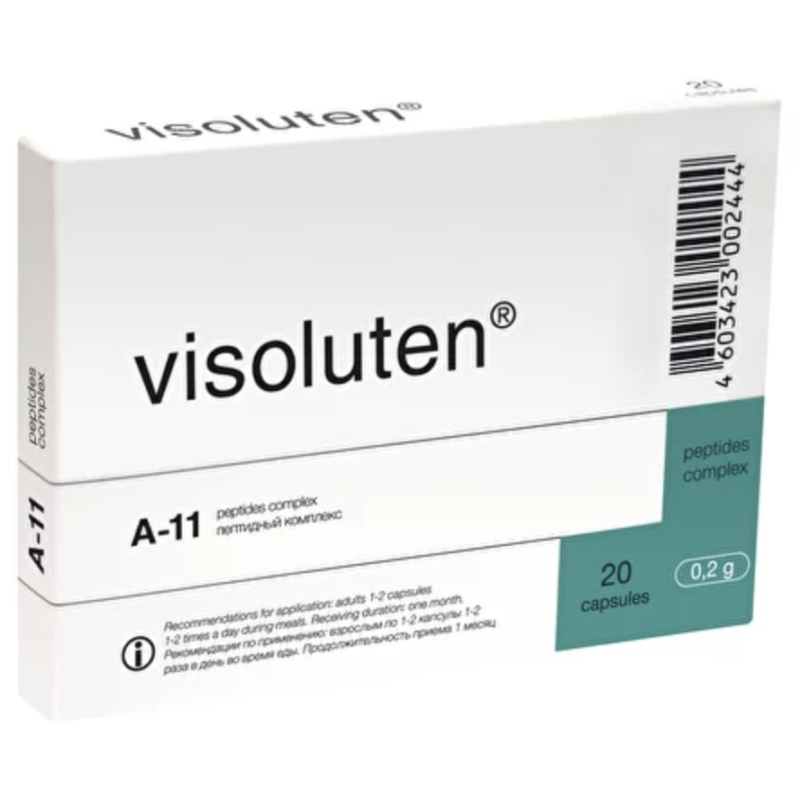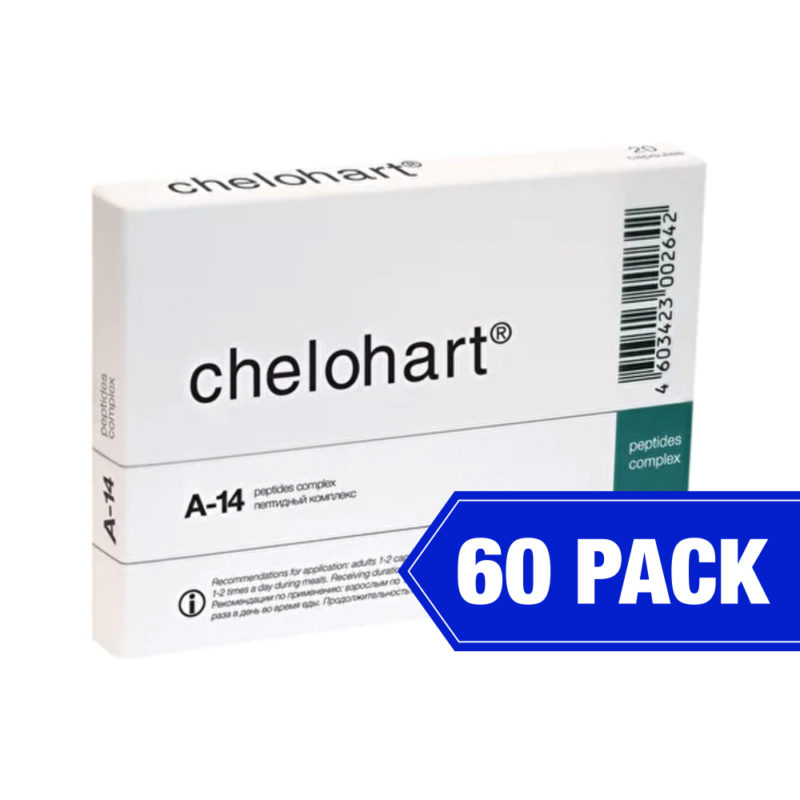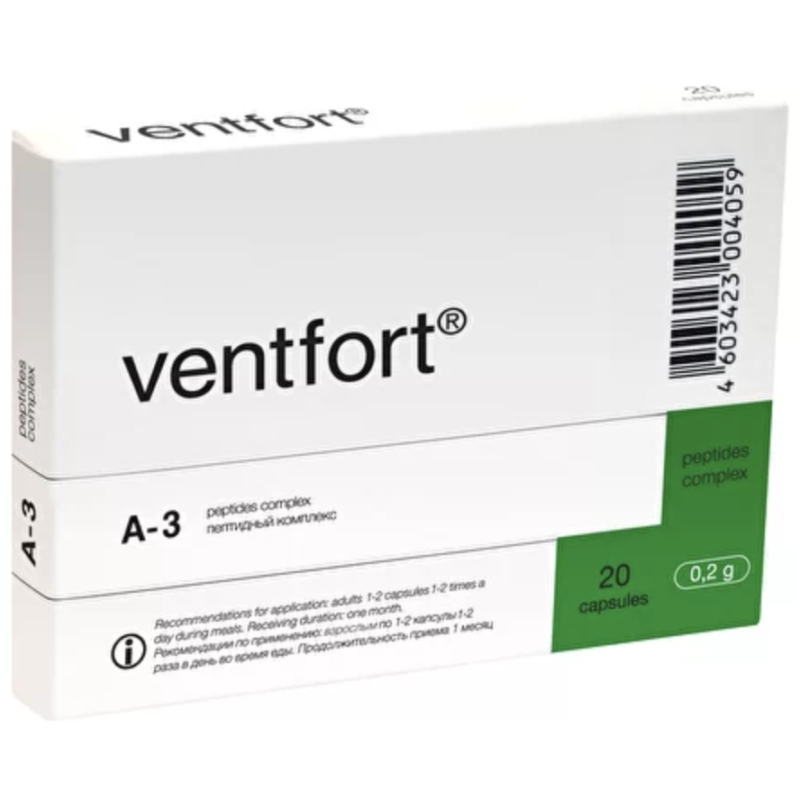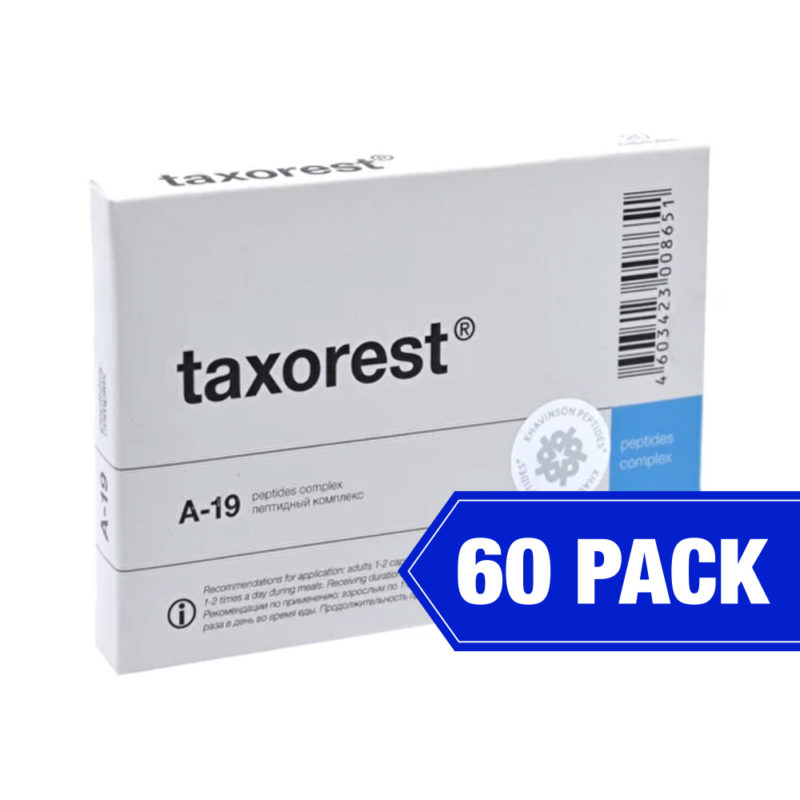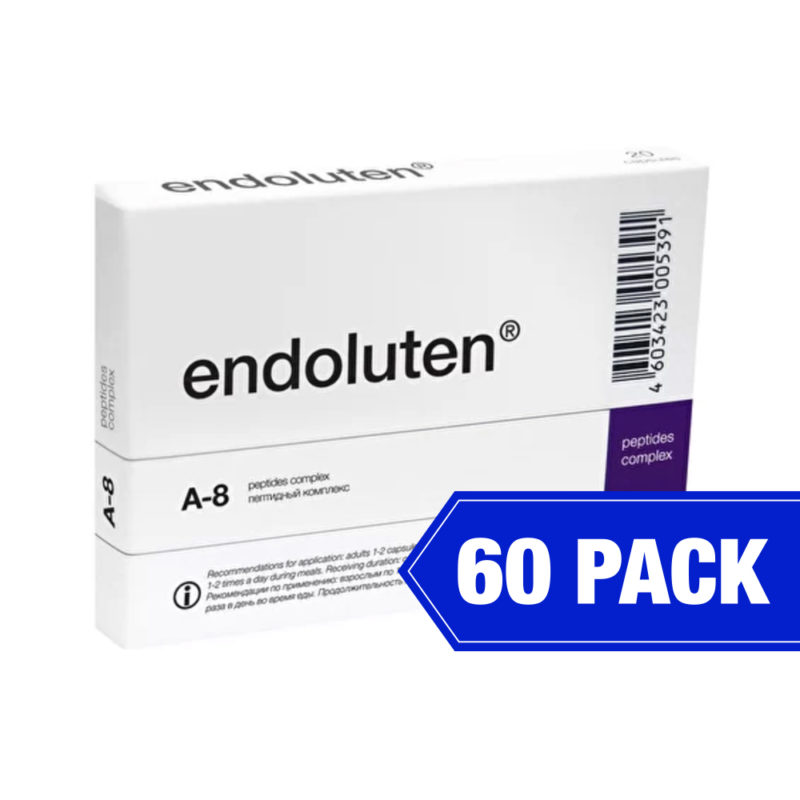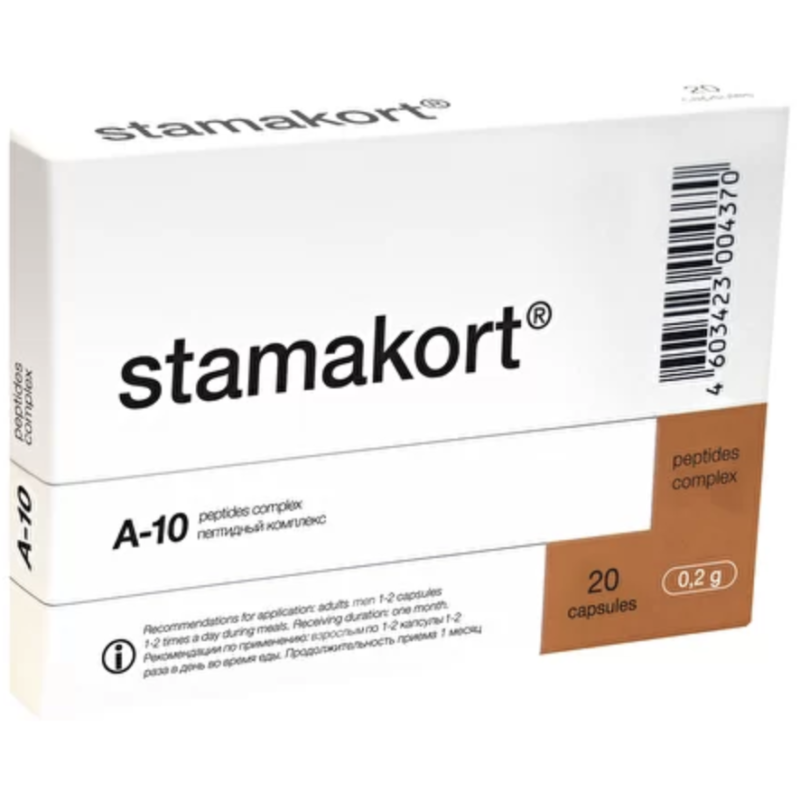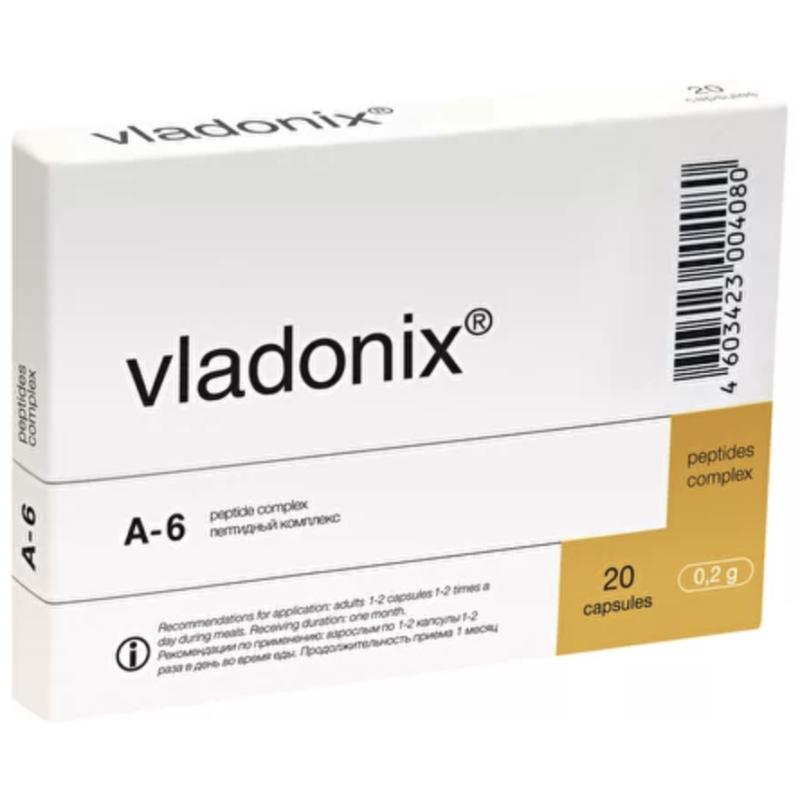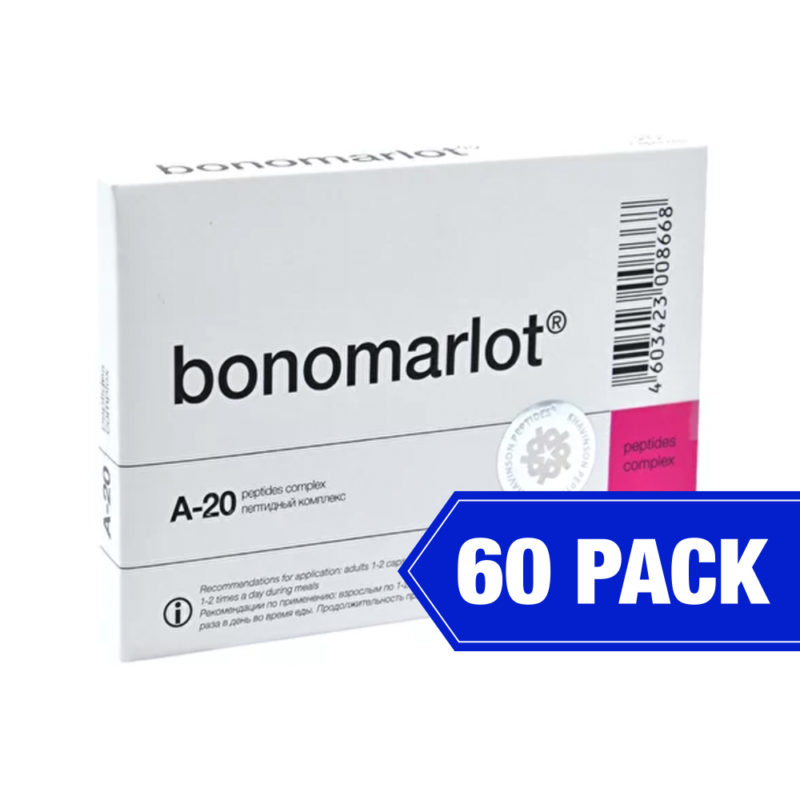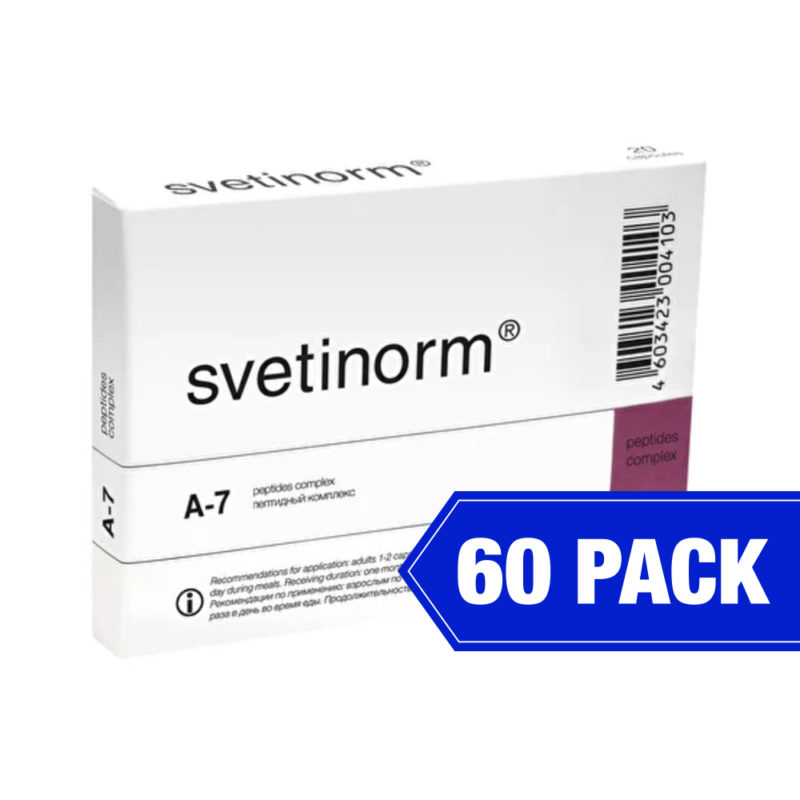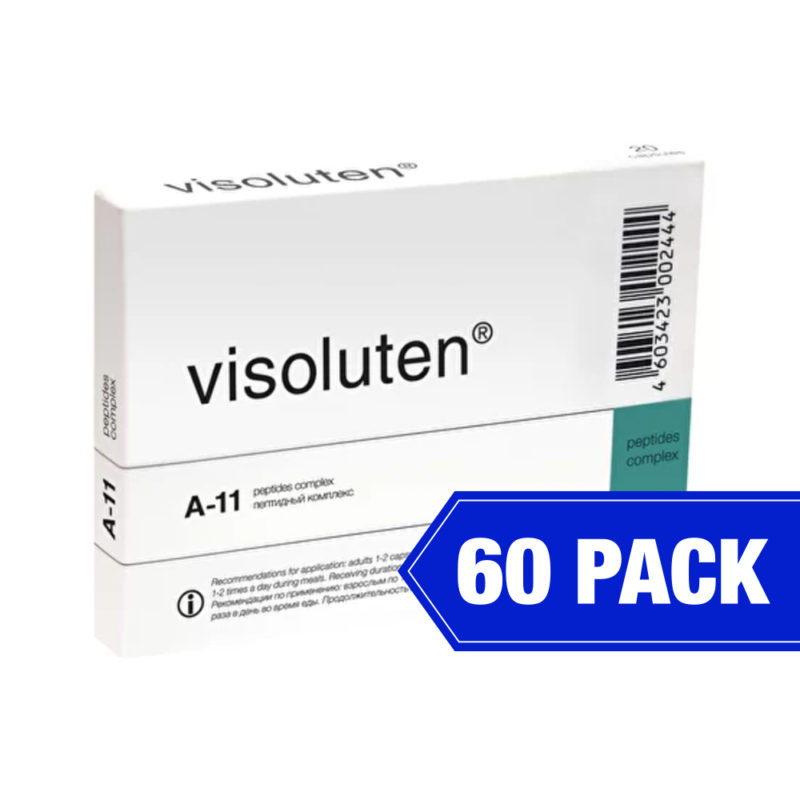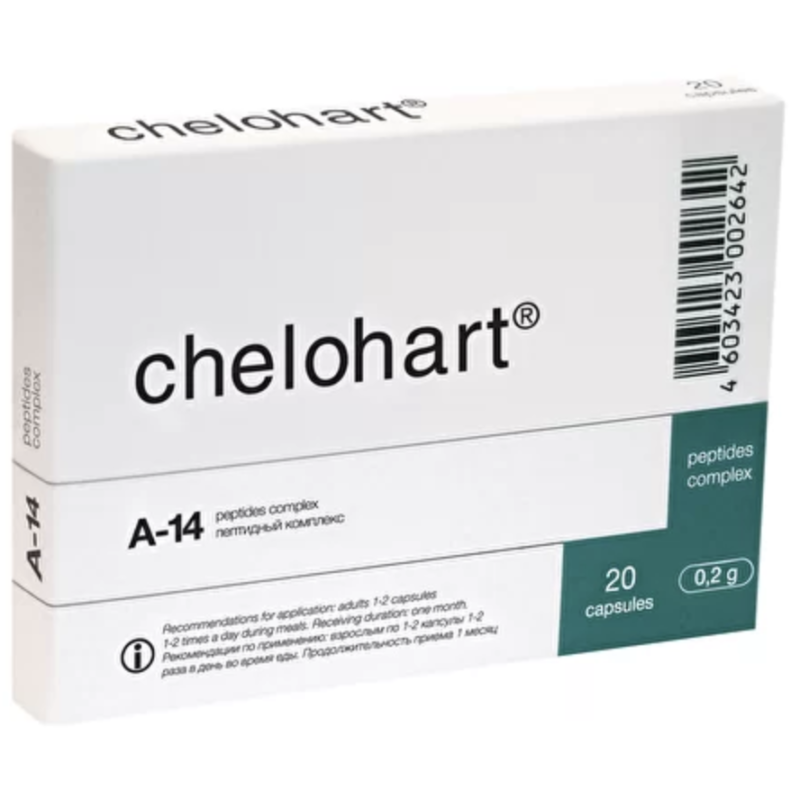Unique method for restoration of retinal functions in case of different diseases
Authors Vladimir Khavanson, V.V. Neroev, S.V., Trofimova, Yu.Yu. Osokina
This publication is dedicated to the application of a complex of peptide bioregulators being highly effective in treatment of different retinal diseases (diabetic retinopathy, pigment retinitis, age-related macular degeneration etc.). It contains data on clinical observations, supported by the results of retinal electrophysiological tests and computer perimetry results.
This publication will be of interest to ophthalmologists and practitioners of medicine in different fields.
Recommended for publication by the Presidium of the Gerontological Society of the Russian Academy of Sciences 1
Relevance of the problem
Maintenance and restoration of functions of the eye, being one of the main sense organs, is among vital issues of modern medicine. 80% of information about environment people get by visual perception. Most of the professional and everyday activities have to do with visual functions, their slackening or loss has the utmost negative effect on the quality of life.
In the structure of the eye retina (nervous tunic of the eyeball) is one of the thinnest layers, being the most complex and highly differentiated tissue. Its complex structure makes it sensitive to light, allowing to perceive color and images and to convert them into a signal being sent straight to the brain. Position of the retina behind other optic structures, direct ingress of sun rays, peculiarities of the blood supply make it vulnerable to both external (sun rays, light striking, radiation) and internal factors. Retina is as a rule damaged in case of the following diseases: hypertension, diabetes mellitus, renal insufficiency etc. Smoking and alcohol consumption also negatively affect retina. It should be noted that any damage of the retina can lead to the impaired vision or even to complete blindness.
Among the most frequent retinal diseases there are age-related macular degeneration, hereditary retinal degenerations (including retinitis pigmentosa), complicated myopia, diabetic retinopathy. Modern methods of treatment based on the application of the known pharmaceutical substances do not lead to significant results. Usually a prognosis for a disease in these patients is unfavorable (gradual and progressive decrease in the visual functions up to blindness).
First reliable positive results of retinal diseases treatment were achieved in the middle 1980ies in Leningrad (Saint Petersburg). The results of the studies conducted at the research laboratory of the S.M. Kirov Military Medical Academy headed by V.Kh. Khavinson served as a basis for the modern concept of peptide regulation of human organism. The authors developed a unique method for isolation from animal organs and tissues of peptides, having direct tissue specific effect. These preparations are complexes of peptides weighing up to 10 KDa. Modern technologies applied in the process of isolation of these peptides preclude any presence of viruses or prions.
In case of introduction into the organism, peptides become inductors of synthesis of the specific proteins, capable of restoring tissues, damaged by a disease or with ageing.
One of the first preparations designed at the Institute was a peptide complex isolated from the cattle retina – Visoluten (RU Patent No 1436305 “Method for producing pharmaceutical substance, stimulating retinal functions”, 25.02.1993.; RU Patent No 2073518 “Pharmaceutical substance, capable of restoring eye retinal functions”, 20.02.1997). Experimental and clinical studies revealed its high efficiency in the treatment and restoration of retinal functions if compared to the known methods. In case of its administration, there were registered a several-fold increase in the rate of the retinal defect closure and restoration of the nervous receptor apparatus, as well as a decreased depression of its functional state (according to the results of the ERG test). Studies have been conducted both on animals with modeled innate retinal degeneration, and on those with induced lesions (including laser ones). In the clinical 2 practice this preparation turned out to be highly effective in the treatment of the aftereffects of retinal veins thrombosis, glaucoma, haemorrhagic retinopathies, retinal sun and laser burns and many other diseases. Numerous studies were conducted in collaboration with the leading medical organizations, such as: S.M. Kirov Military Medical Academy, the Helmholtz Moscow Research Institute of Eye Diseases, State Research Institute of Eye Diseases of the Russian Academy of Medical Sciences, Main Military Clinical Hospital named after N.N. Burdenko of the Ministry of Defence of the Russian Federation etc.
At the same time there were also conducted clinical trials of other peptides, isolated from the pineal gland, thymus, cortex, vessels and other organs. Positive results of the clinical studies allowed to introduce these preparations into the Russian Pharmacopoeia.
A complex of peptides isolated from the pineal gland called Endoluten, turned out to be highly effective in case of complex treatment of diabetic retinopathy. This preparation also revealed pronounced antioxidant effect and especially pronounced geroprotective effect, contributing to the improvement of the cortex functions and reducing stress level (RU Patent No 2163129, 20.02.2001; RU Patent No 2302870, 22.06.2007).
A complex of peptides isolated from the cortex called Cerluten also turned to be highly effective in case of complex treatment of all retinal diseases (RU Patent No 1298979, 16.02.1993). Cortexin exerts tissue specific effect on the cortex, contributes to the restoration of cerebral cortex neurons, improves processes of nervous management and adaptation of the organism to variable environmental conditions, activates cerebral cortex, exerts antioxidant and antitoxic effects. The preparation improves processes of memorizing, stimulates DNA reparation in the cortex and accelerates brain functions restoration after stress impact and ischemia. These effects are especially relevant for retina being a nervous tissue.
A complex of peptides isolated from the calves thymus called Thyreogen significantly enhances immune system activity and is effective in complex treatment of retinal diseases (RU Patent No 1077089, 05.04.1993). This preparation stimulates tissue regeneration and hemapoiesis, suppresses tumour growth, reduces treatment period of chronic diseases.
A complex of peptides isolated from the vessels called Ventfort (RU patent No 2301072, 20.06.2007), significantly enhances rigidity of the vascular wall, and considerably contributed to the effective treatment of retinal diseases. Its application caused reduction in the vascular wall permeability, reduction in the haemorrhages size and acceleration of their resolution, reduction of neovascularisation.
The efficiency of the complex application of these peptide preparations in case of different retinal pathology was considerably higher if compared to the separate application.
Recently at the Saint Petersburg Institute of Bioregulation and Gerontology, a unique method for restoration of the damaged retina based on the application of peptide bioregulators was developed. (RU patent No 1298979, 16.02.1993; RU patent No 2073518, 20.02.1997; RU patent No 2195297, 27.12.2002; RU patent No 2302871, 20.07.2007). A set of peptides for the treatment course is designed taking 3 into consideration specificity of the eye ball structure, and depending on the allocation and type of the damage as well as on the general state of the patient it includes peptides of the retina, thymus, pineal gland, cortex, vessels and other. It turned out that peptide bioregulators are most effective in case of age-related macular degeneration, retinitis pigmentosa, complicated myopia, diabetic retinopathy.
In recent years the Institute of Bioregulation and Gerontology has synthesized and studied a new group of peptide bioregulators being analogues of the complex peptide preparations. The activity of these preparations is higher than that of the earlier designed. These synthetic peptides are utterly promising for the application in practical medicine. These are short peptides (2-4 amino acids) of the retina, pineal gland, cortex, thymus, vessels etc. Also, a preparation which inhibits angiogenesis, has been synthesized, being very important especially for the diabetic retinopathy pathogenesis and lesion of the organs and tissues associated with diabetes in general (RU patent No 2177801, 10.01.2002). These peptides (Normoftal, Pancragen, Vesugen, Crystagen, Pinealon etc.) are widely used in the medical practice as the means for prevention and treatment of different eye diseases.
Since 1995 up to 2010 at the Medical Centre of the Saint Petersburg Institute of Bioregulation and Gerontology there had been treated 1500 patients with different retinal pathology: 40.3% – with macular degeneration; 30.3% – with diabetic retinopathy, 23.0% – with retinitis pigmentosa and 6.4% – with other eye diseases. Before the onset of each course and after its termination the patients were subjected to a complex ophthalmologic examination. The efficiency of the conducted treatment course was evaluated according to the indices of visual acuity, electrophysiological test, eye ball image and subjective state of each patient. Improved visual functions were registered in 95% of the patients. 5% of the patients with pronounced retinal lesions, caused by long existing diseases, didn’t report any changes after the treatment course. It should be noted that in none of the cases there were registered any worsening of the visual functions.
Recently at the Saint Petersburg Institute of Bioregulation and Gerontology we have gained quite wide experience of treatment of such patients. We manage not only to stop the development of the pathologic process but in many cases also to restore lost functions. Peptide bioregulators are effective in the treatment of both wet and dry macular degenerations. We’ve designed tableted form of the preparations (biologically active supplements) which effect is comparable to the effect of those for injections (RU patent No 2295970, 27.03.07; RU patent No 2363488, 10.08.2009). Application of these tableted preparations allows to extend effect of the injection preparations or even to substitute them. The effect is preserved in case of long-term treatment. Regular application of peptide bioregulators allows to enhance the achieved results while other preparations being applied in conservative treatment of this pathology (including such wide-spread preparations as Lucentis and Avastin) require intraocular administration.
We can definitely assert that nowadays in the world of medicine, there are no methods of treatment for retinal diseases whose efficiency is comparable to that of the treatment with peptide bioregulators.
Application of peptide bioregulators in case of diabetic retinopathy
According to different sources the world number of patients suffering from diabetes mellitus accounts for 230-245 million people [2,4,5,18]. In the developing countries up to 6% of the population suffer from this disease while in the countries of the Latin America these patients account for almost 15% of the population [13,14,18,20]. In Russia there are registered about 3 million people with diabetes mellitus including 260 thousand of those insulin dependent. Meanwhile according to the epidemiologic studies the number of people with diabetes accounts for 8 million people [1,4,9]. One of the most severe complications of the diabetes mellitus is a diabetic retinopathy, which is a progressive lesion of the retina, requiring laser and surgical intervention. Retinopathy develops in 97% of patients suffering from the diabetes mellitus type 1 for 20 and more years, and in 80-95% of the patients suffering from diabetes mellitus type 2 [5,6].
Method of treatment of this disease designed at the Saint Petersburg Institute of Bioregulation and Gerontology besides antihyperglycemic preparations comprises a unique combination of peptides (RU patent No 2157154, 10.10.2000; RU patent No 2242241, 20.12.2004; RU patent No 2295970, 27.03.2007; RU patent No 2363488, 10.08.2009). In case of application of this treatment scheme diabetic retinopathy not only does not aggravate, but also there is registered a tendency to reverse progress. Peptide bioregulators enhance activity of the blood antioxidative system, including enzymes of the antioxidative defence, due to neutralization of highly toxic hydroxyl and peroxyl radicals, generated in the process of free radicals oxidation, this being very important in case of diabetes. They contribute to restoration of the damaged structures of the vascular wall and intercellular contacts restoration, affecting processes of the intracellular regulation. As a consequence they resolve haemorrhages and plasmorrhages, lessen edemata, regenerate and enhance cellular living potential.
In several cases in patients, who suffer from a very severe form of this disease associated with a severe proliferative process, after several courses of peptide bioregultors it became possible to conduct surgical treatment, which before had been denied to these patients due to its hopelessness.
Among those long-standing and evidencing clinical observations we should mention patient A.Ya. Khavinson, born in 1920 (Professor Khavinson’s mother), who has been taking peptide bioregulators due to diabetic retinopathy for 25 years. Nowadays, at the age of 90, she still has good vision.
Further on we give an example of one of our clinical observations.
Clinical observation No 1.
Patient M.E.E., born in 1972.
Diagnosis: diabetes mellitus type 2, proliferative diabetic retinopathy, pseudophakia, right eye subatrophy, condition after the vitrectomy in the left eye.
The patient had been being observed at the Medical Centre of the Saint Petersburg Institute of Bioregulation and Gerontology from 1999 till 2005. She underwent 11 courses (10 days each) with a complex of bioregulators. Visual acuity upon admission – 0.4-0.5, on discharge – 0.85. During the period of observation there were registered a significant widening of the field of vision in the sole seeing eye and considerably improved ERG indices. 4
Results of the visual functions tests before and after the treatment course
Field of vision test (computer based perimetry, ‘Pericom’)
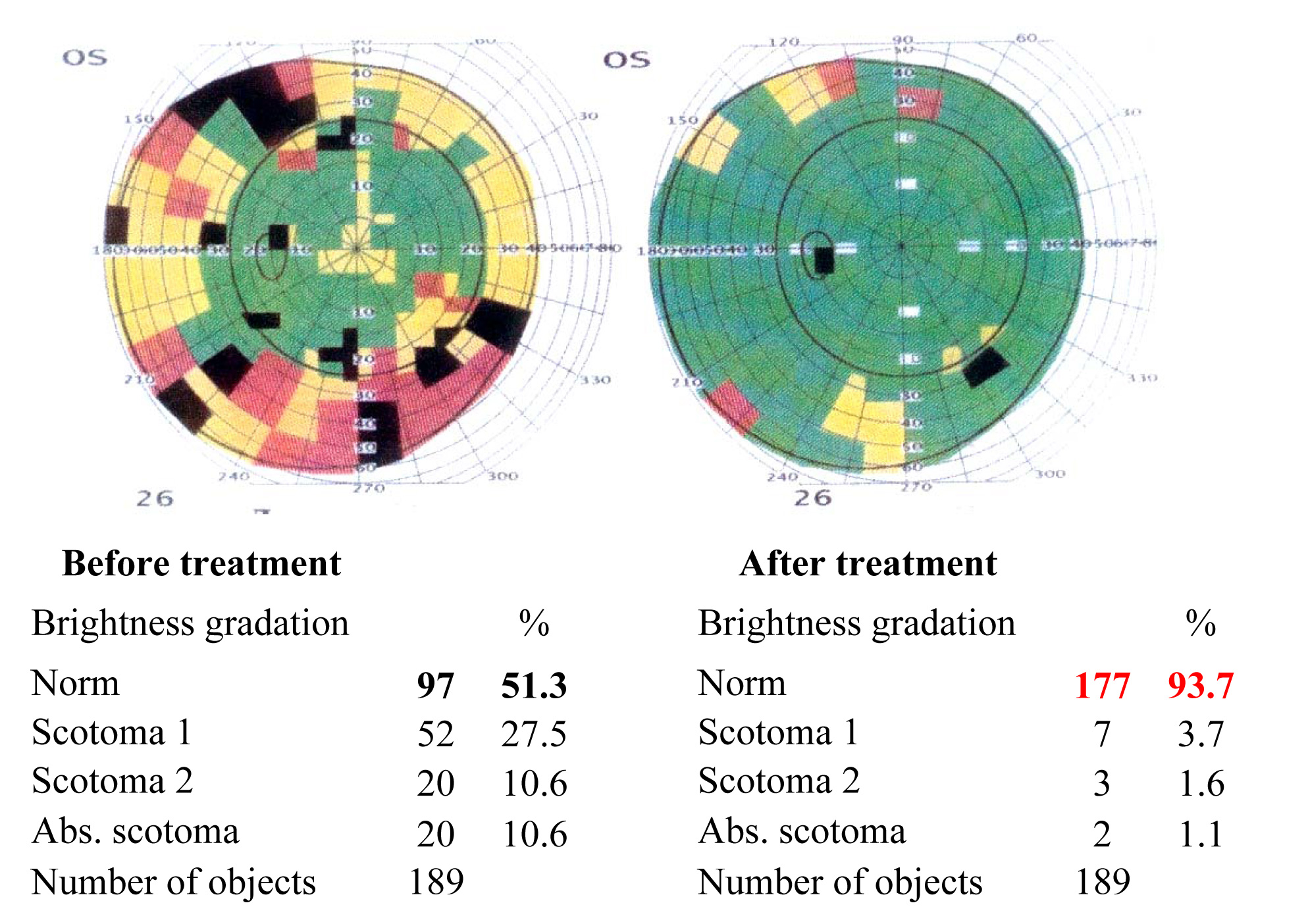
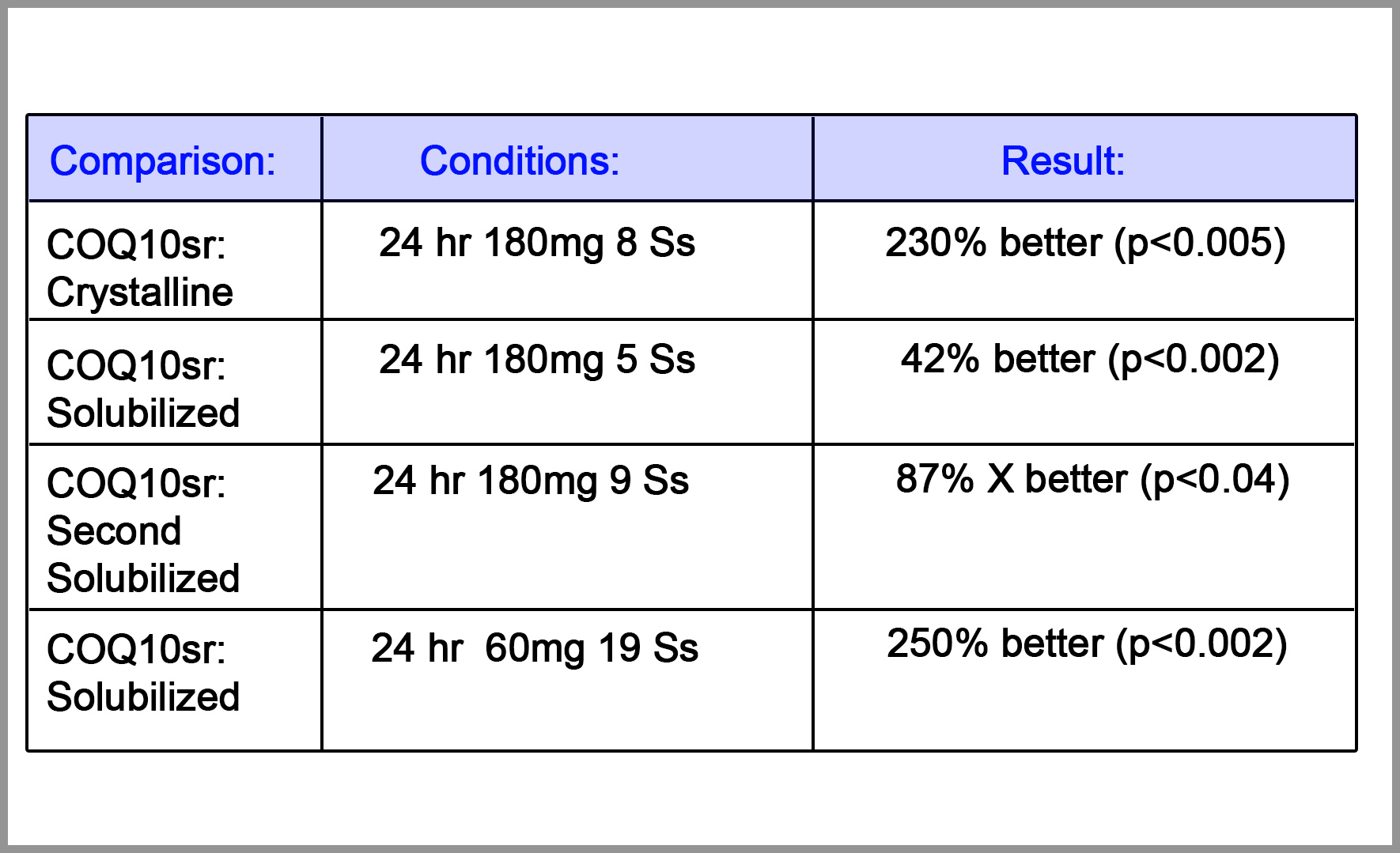
Peptides application in case of retinitis pigmentosa (RP)
Retinitis pigmentosa is one of the most severe and frequent hereditary retinal diseases [15,26]. Its prevalence in the world on the average accounts for one patient per 5000 people [10,11]. S.F. Shershevskaya [11] reported 0.01% cases of retinitis pigmentosa in unselected population. The rate of carriage is 2% [8].
At the Medical centre of the Institute we’d treated patients from different countries who failed to get any help in any other medical institutions and came to us after several years of desperate attempts to improve or stabilize their vision functions.
We should emphasize that right after the first treatment course they reported increased visual acuity, significant widening of the fields of vision, improved scotopic (twilight) vision. With every reason we may say that there are no examples of such positive results observed after the treatment of this pathology in the world. In case a patient regularly undergoes courses of peptide bioregulators we reveal no negative dynamics of this severe pathology at all.
Clinical observation No 2.
Patient D.P.S., born in 1936.
Diagnosis: Pigment retinal degeneration in both eyes, low myopia in both eyes, pseudophakia in the left eye, initial cataract in the right eye.
Concomitant diagnosis: Prostate gland adenoma, cerebral atherosclerosis.
The patient was being observed at the Medical Centre of the Saint Petersburg Institute of Bioregulation and Gerontology from 2003 till 2010. He underwent 12 courses (10 days each) with a complex of bioregulators. During the period of observation there were being registered significant widening of the field of vision and considerably improved ERG indices.
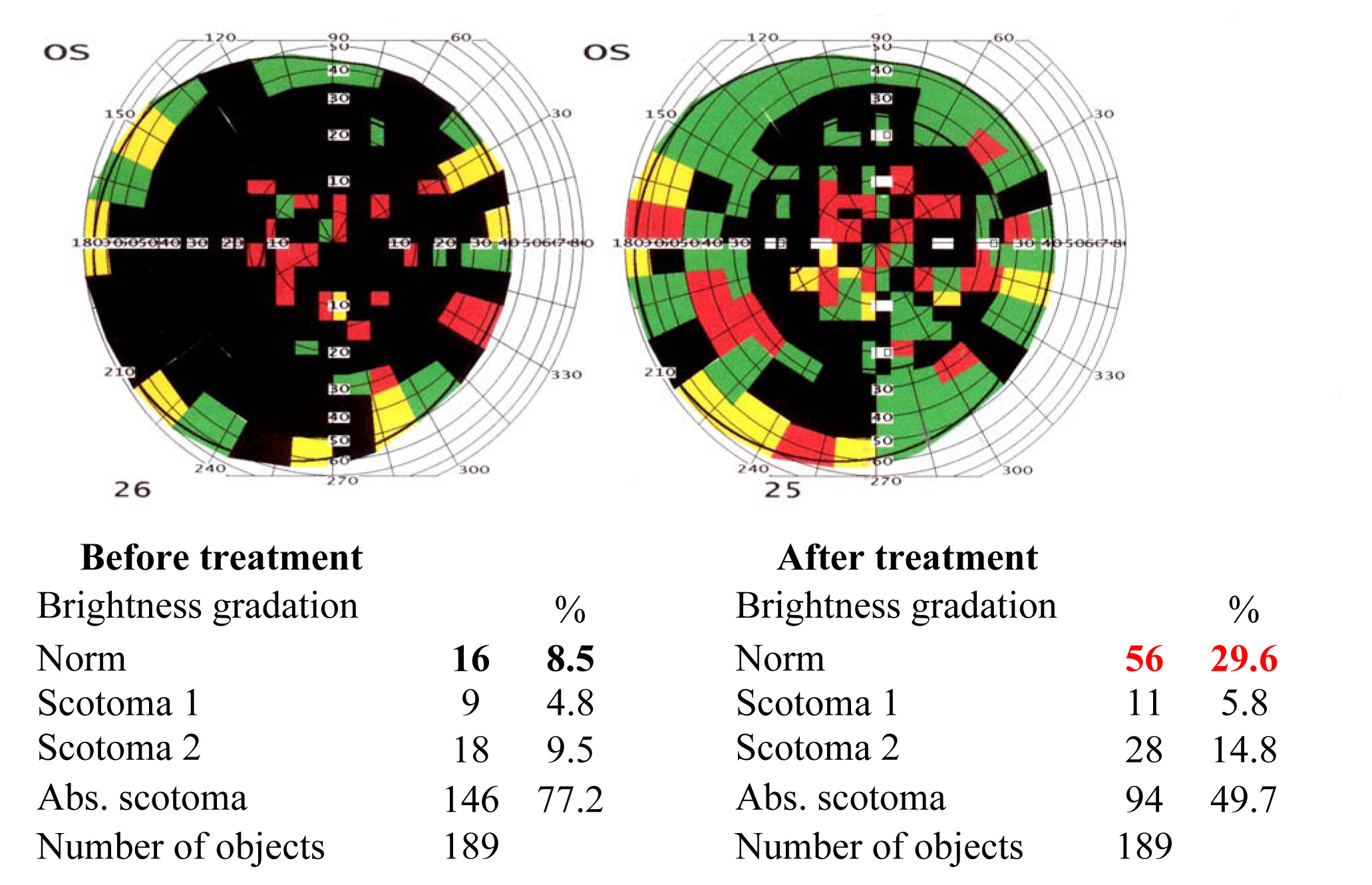
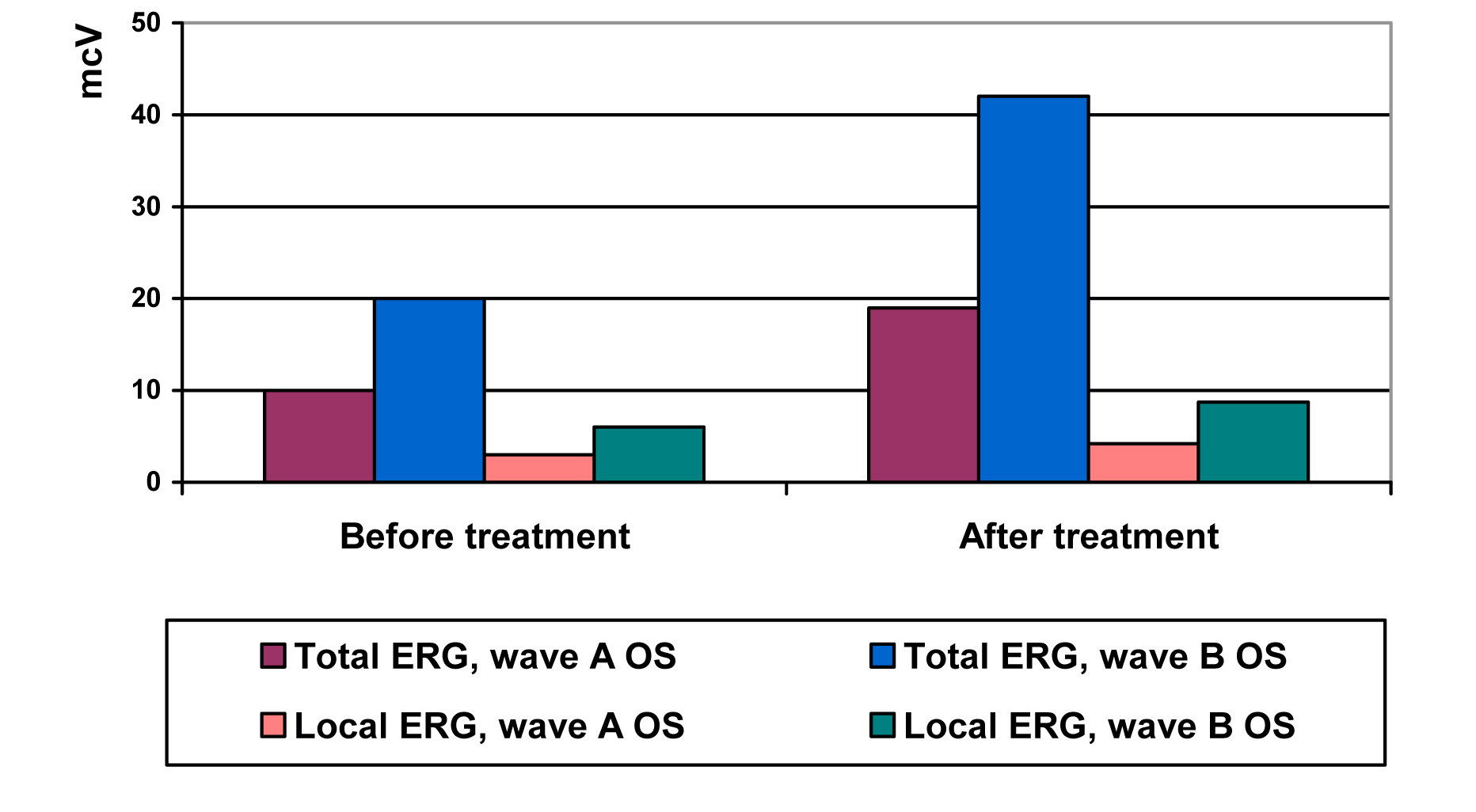
Peptides application in case of age-related macular degeneration
In the developed countries of the world as well as in the USA age-related macular degeneration is a leading cause of the blindness in patients aged 50+ [12,14,16,17,19,21,25,30].
According to the official data of the Centre of the World Health Organization on Prevention of the Recoverable Blindness its frequency accounts for 300 cases per 100 thousand of population, and in the world in general there are 25-30 million people suffering from this disease [3]. R. Klein et al. [22,23], B. Klein [24] show that first symptoms of this disease are registered in 40% of people aged 40+, and in more then 60% of people aged 60+ according to R.A. Williams et al. [29]. In Russia the general number of people with age-related macular degeneration in the age group 40+ accounts for 1.5%, while the general number of people with this pathology accounts for 750 thousand [27,28].
The World Health Organization reports that by 2025 this disease will be registered in 25% of the total world population. Age-related macular degeneration morbidity rate in the last decades reveals epidemic trends. 7
Clinical observation No 3.
Patient A.O.N., born in 1936.
Diagnosis: age-related macular degeneration, initial cataract, hypertonic retinal angiopathy in both eyes.
Concomitant diagnosis: hypertension. The patient came to the Medical Centre of the Saint Petersburg Institute of Bioregulation and Gerontology in 2003. She underwent 2 courses (10 days each) with a complex of bioregulators. During the period of observation there were being registered significant widening of the field of vision and considerably improved ERG indices.
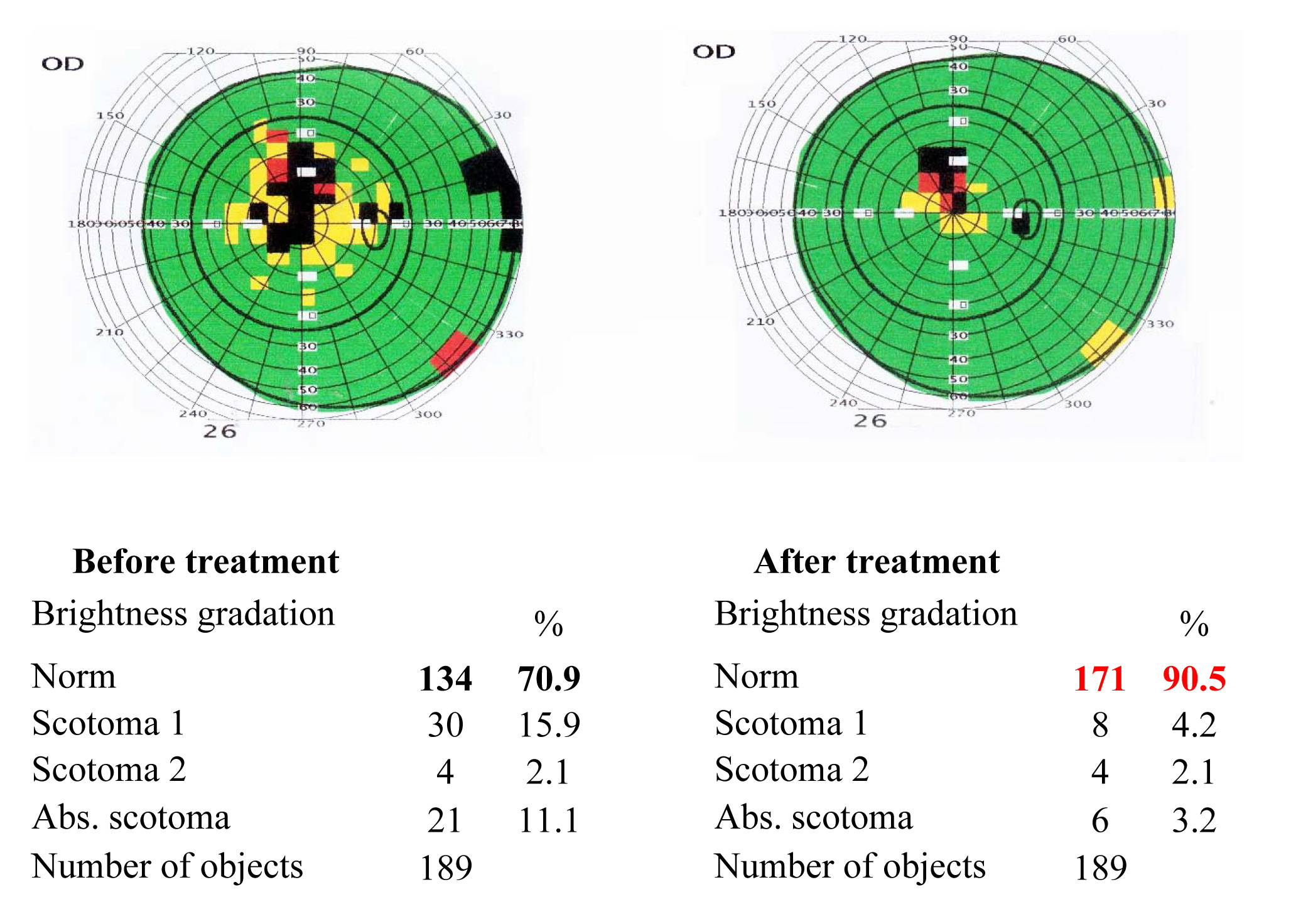
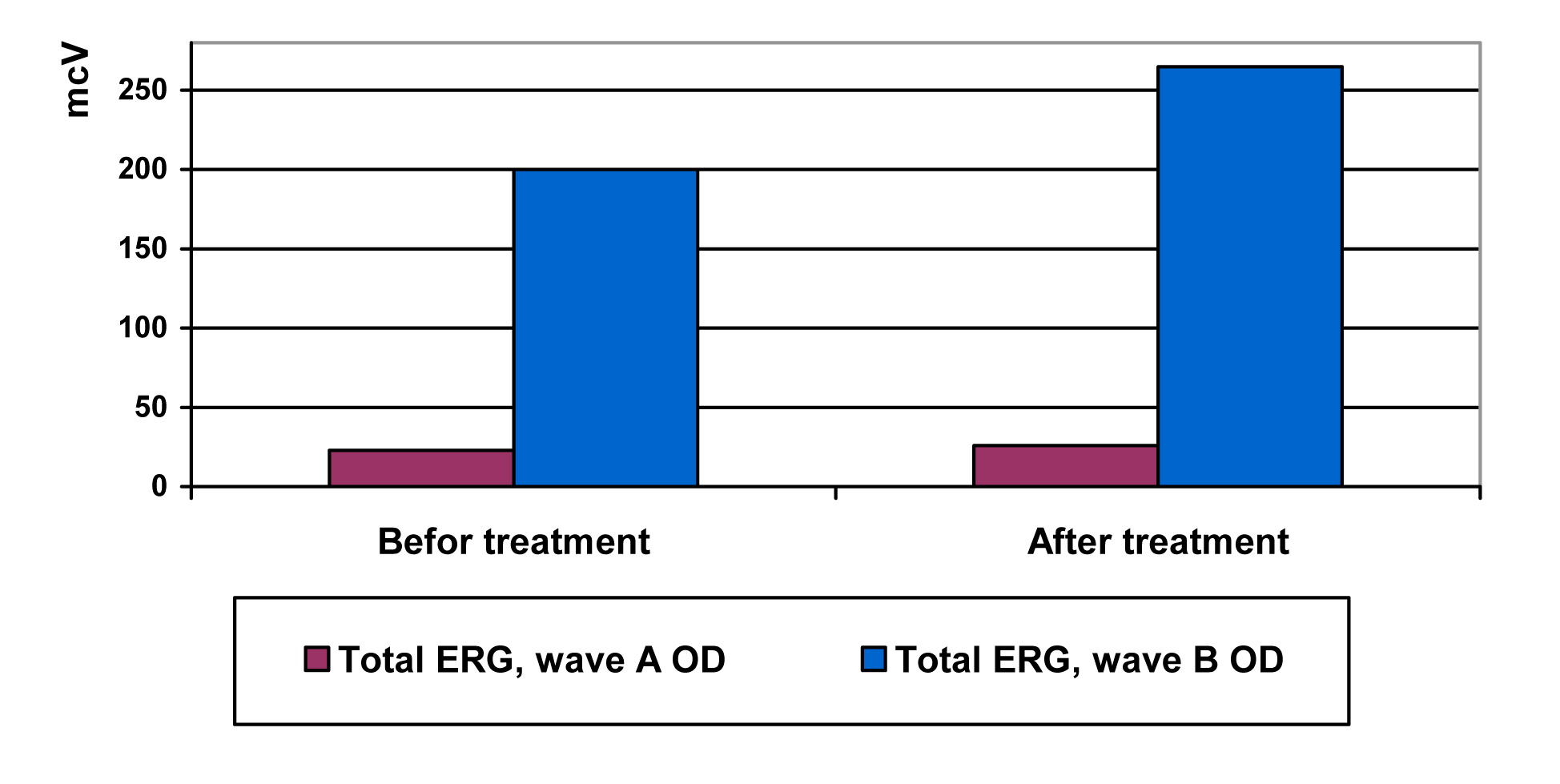
Peptides application in case of other eye diseases
Encouraging results were obtained in case of treatment of other diseases associated with retina functions impairment. For instance, high myopia is often associated with the complications such as haemorrhages and (or) retinal degenerations. This causes a significant impairment of visual functions and even complete blindness. Administration of peptide bioregulators (RU patent No 2161982 issued 20.01.2000, RU patent No 2301072 issued 20.06.2007, RU patent No 2301678 issued 27.06.2007) allows to reduce severity of these complications and achieve significant positive dynamic in visual functions.
Clinical observation No 4.
Patient B.H., born in 1942.
Diagnosis: complicated high myopia, pseudophakia in both eyes.
Before Mr. B. came to the Saint Petersburg Institute of Bioregulation and Gerontology he had been treated at the leading ophthalmologic clinics in Europe and Japan. Since 2004 he has been being observed at the Medical Centre of the Saint Petersburg Institute of Bioregultaion and Gerontology. He has already undergone 14 courses (10 days each) with a complex of bioregulators. During the period of observation there were being registered narrowing of scotomata and considerably improved ERG indices.
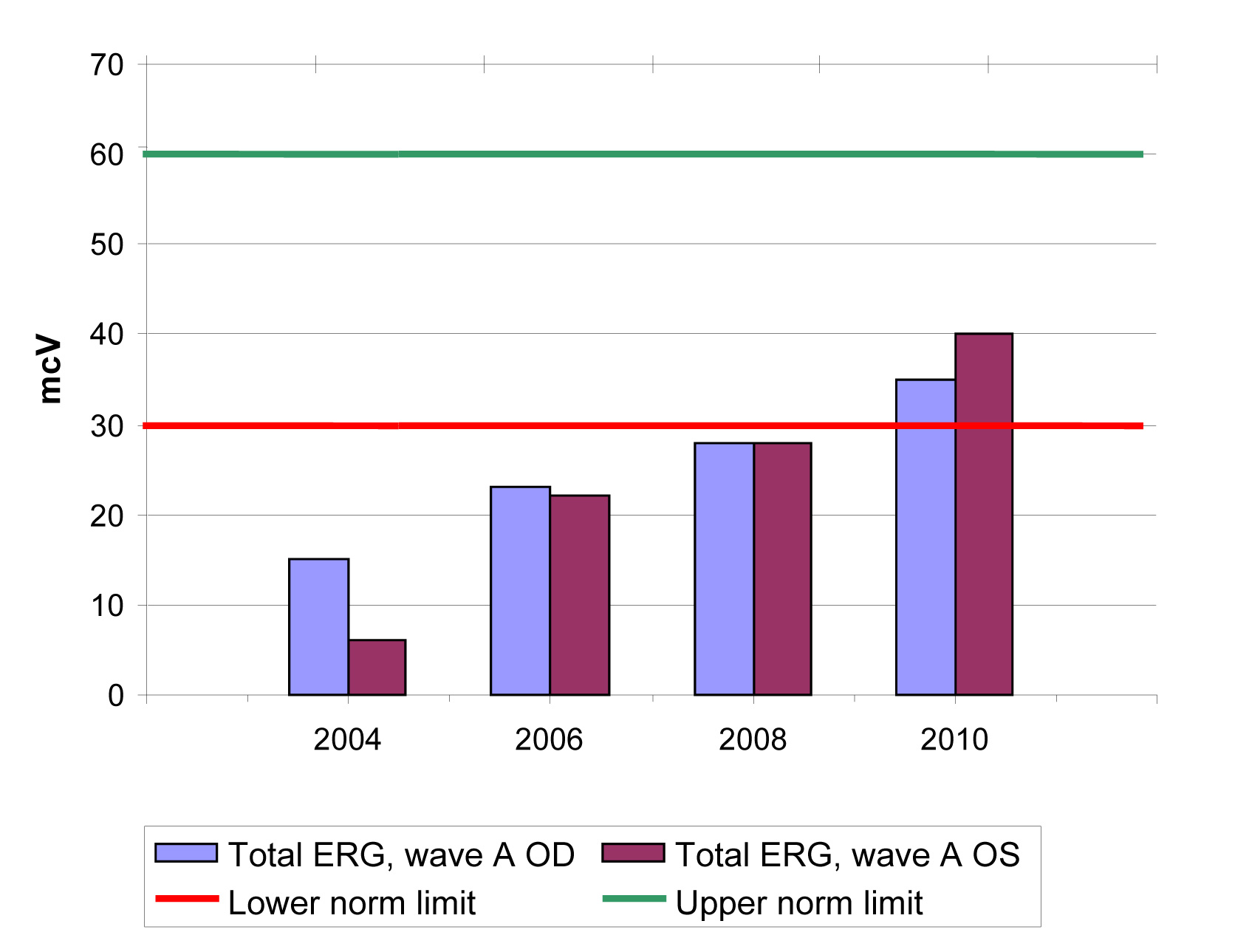
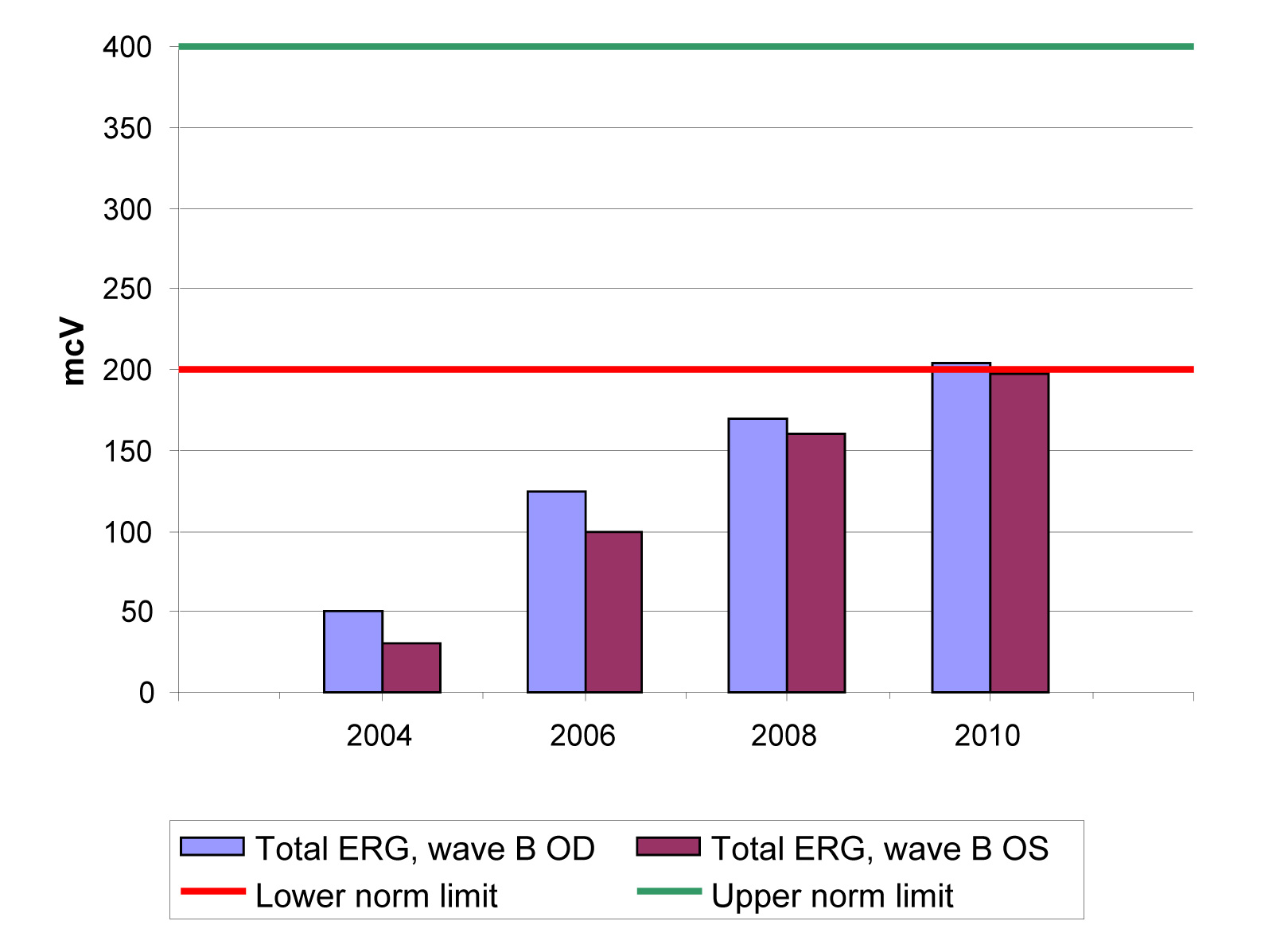
Fast and pronounced improvement is also registered when peptide bioregulators are administered in patients with macular retinopathies of different etiology (chorioretinitis, burns (sun burns, laser burns), central serous chorioretinopathy etc.
Clinical observation No 5.
Patient K.O.L., born in 1980.
Diagnosis: transsudative macular degeneration, fibrovascular retinal cicatrix in the right eye, high myopia in both eyes.
The patient was being observed at the Medical Centre of the Saint Petersburg Institute of Bioregulation and Gerontology from 2004 till 2009. She underwent 6 courses (10 days each) with a complex of bioregulators. During the period of observation there were being registered narrowing of the central scotoma and considerably improved ERG indices.
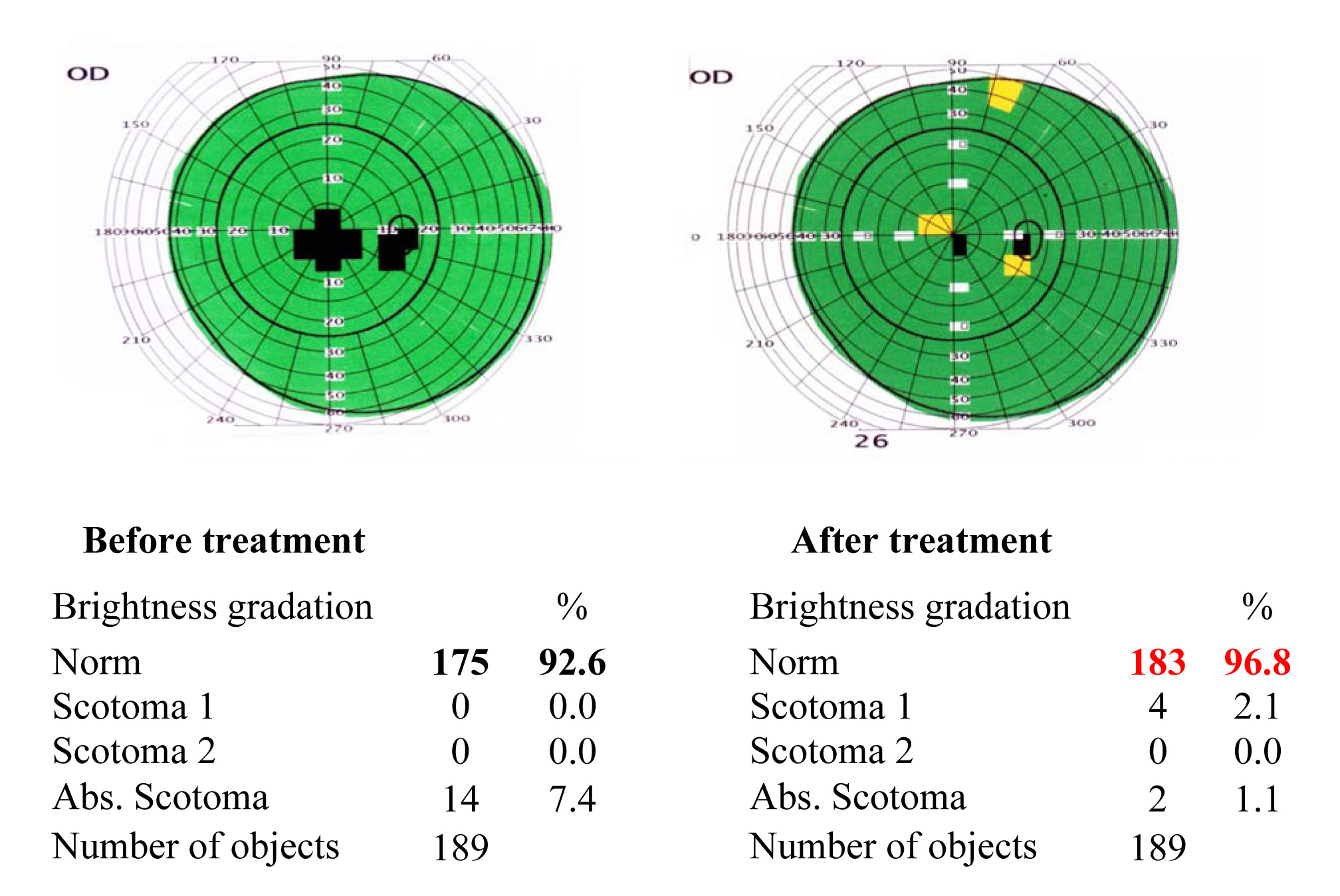
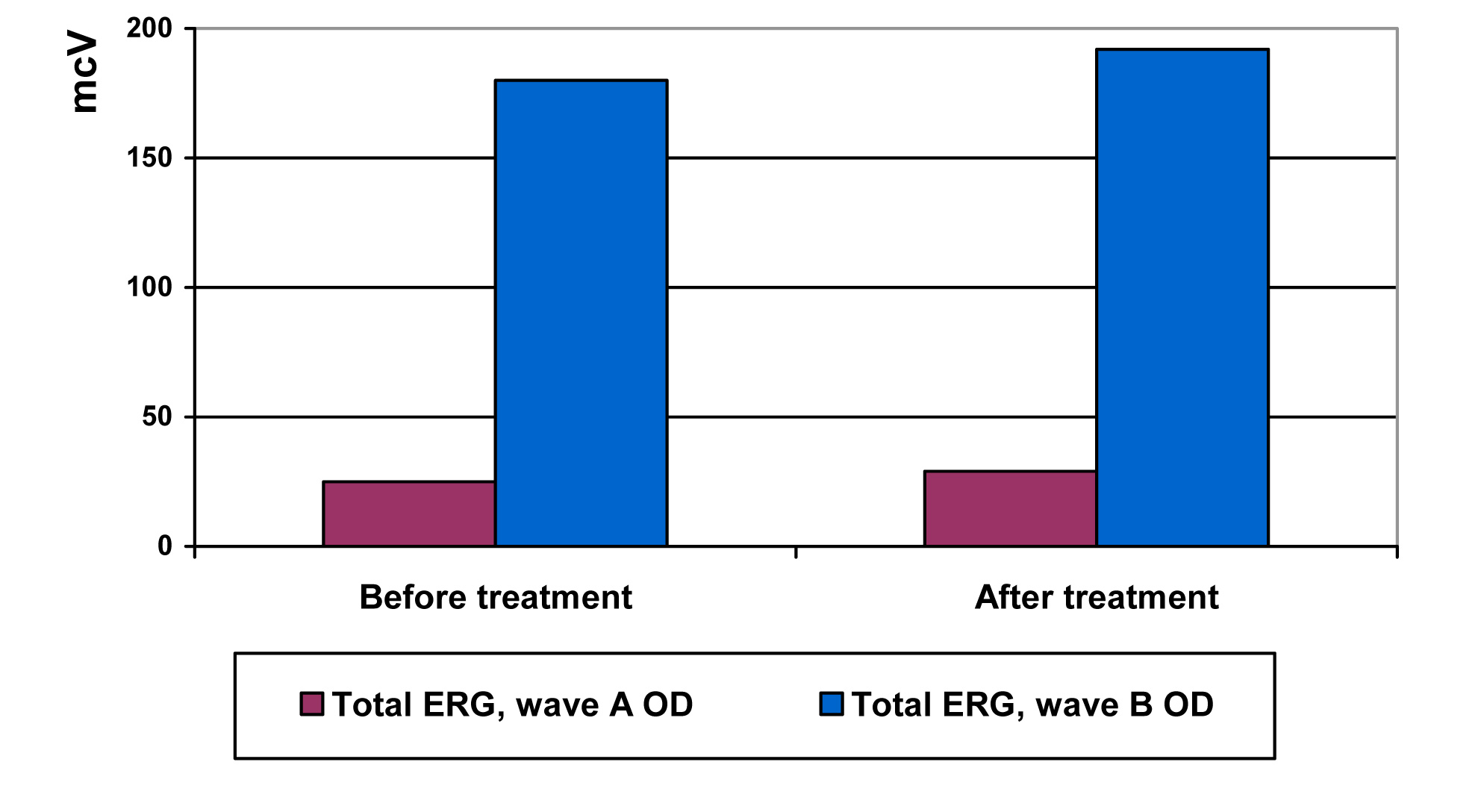
Clinical observation No 6.
Patient D.A.N., born in 1958.
Diagnosis: tuberculous chorioretinitis (cicatricial stage) in the right eye, high myopia in both eyes.
The patient came to the Medical Centre of the Saint Petersburg Institute of Bioregulation and Gerontology in 2004 having undergone a course at the TB dispensary. She underwent 1 course (10 days) with a complex of bioregulators. During the period of observation there were being registered significant widening of the field of vision and considerably improved ERG indices.
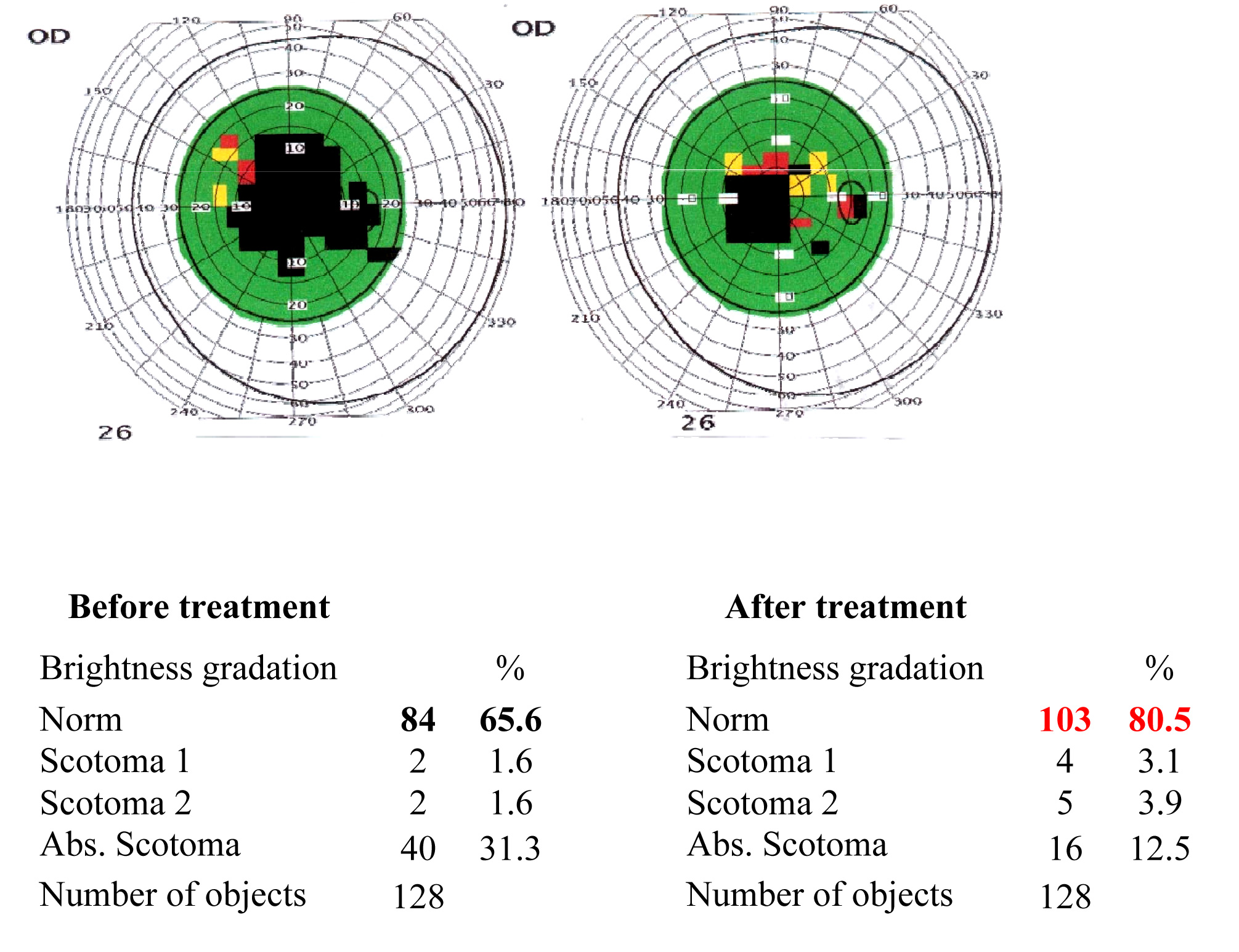
Clinical observation No 7.
Patient K.Yu.A., born in 1936.
Diagnosis: Open-angle IIIa operated glaucoma in the right eye, open-angle IVb operated glaucoma in the left eye.
The patient came to the Medical Centre of the Saint Petersburg Institute of Bioregulation and Gerontology in 2006 having undergone a course surgical and laser treatment for glaucoma in both eyes. The patient has been being observed for glaucoma since 1988. At the Medical Centre of the Saint Petersburg Institute of Bioregulation and Gerontology the patient has undergone 11 treatment courses.
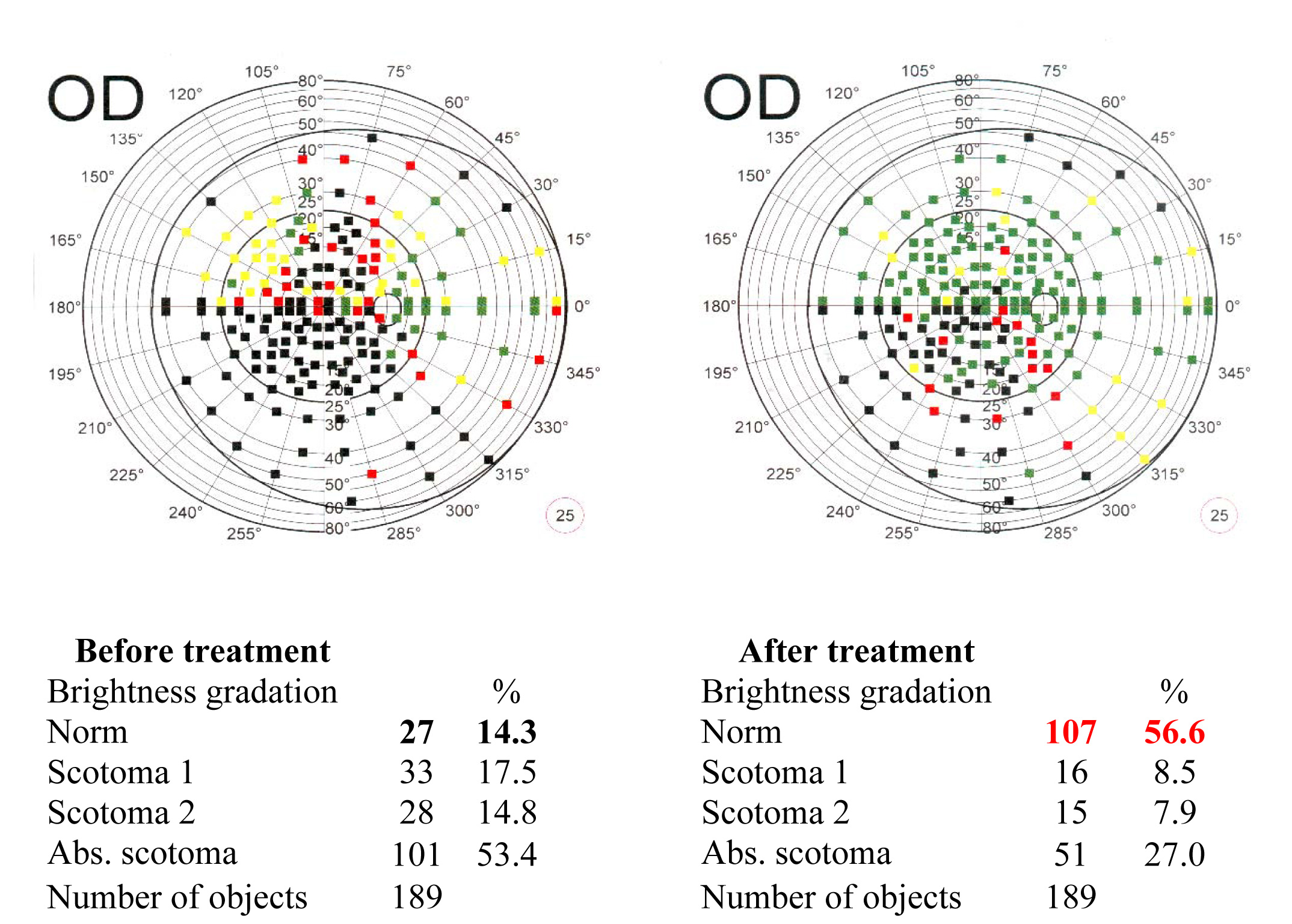
Conclusion
For the first time in the world of medical practice there has been developed a unique method for restoration of the damaged retina in case of different diseases (such as diabetic retinopathy, innate and acquired degenerations, complicated myopia, maculopathies, chorioretinitises, burns). The method is based on the application of a complex of bioregulators, isolated from the retina, vessels, pineal gland, thymus, or their synthetic analogues. The efficiency of this complex treatment is 95%, which is an unprecedented achievement in the field of ophthalmology. Wide application of bioregulators will contribute to the enhancement of the working capacity period, reduce the rate of disabilities, enhance quality of life of the patients. All these may positively affect social and economic aspects of the medical care system efficiency in Russia.
Authors:
Khavinson Vladimir – President of the International Association of Gerontology and Geriatrics – European Region, director of the Saint Petersburg Institute of Bioregulation and Gerontology, Vice President of the Gerontological Society of the Russian Academy of Sciences, Member of the Russian Academy of Medical Sciences, Professor, Doctor of Medicine. Author of 700 scientific publications, including 27 monographs, 186 Russian and International patents.
Neroev Vladimir – director of the Helmholtz Moscow Research Institute of Eye Diseases, main specialist in ophthalmology of Ministry of Health and Social Development of the Russian Federation, Professor, Doctor of Medicine. Author of 180 scientific publications, including 3 monographs, 30 patents.
Trofimova Svetlana – deputy director, Medical Centre of the Saint Petersburg Institute of Bioregulation and Gerontology, Head of the Ophthalmologic laboratory of the Saint Petersburg Institute of Bioregulation and Gerontology, Professor, Doctor of Medicine. Author of 150 scientific publications, 5 patents.
Osokina Yulia – head, Ophthalmologic Department of the Medical Centre of the Saint Petersburg Institute of Bioregulation and Gerontology, Ph.D. Author of 55 scientific publications.
References
In Russian
1. Balabolkin M.I., Klebanova E.M., Kreminskaya V.M. Differentiative diagnostics and treatment of the endocrinology diseases. Handbook. // M.: Medicine. – 2002. – 752 p.
2. Brink S. Endocrinology. // M.: Medicine. – 1999. – 802 p.
3. Bolbas Z.V., Vasilevskaya N.A., Chikun E.A. Age-related macular degeneration: growth factor of the VEGF endothelium vessels, chaperone Rре65 and PPAR receptors as promising targets for medicamental therapy. // Russian med. vesti. – 2010. – № 3. – P. 36-38.
4. Dedov I.I. Diabetes mellitus in the Russian Federation: issues and ways out. // Diabetes mellitus. – 2001. – № 1. – P. 7-18.
5. Dedov I.I., Fadeev V.V. Introduction in diabetology. // М.: “Bereg” publishing house. – 1998. – 200 p.
6. Dedov I.I., Shestakova M.V., Milenkaya T.M. Diabetes mellitus: retinopathy, nephropathy. // М.: Medicine. – 2001. – 176 p.
7. Dedov I.I., Shestakova M.V. Diabetes and arterial hypertension. // M: OOO “Medical information agency”. – 2006. – 343 p.
8. Kaznelson L.A. Agranovich M.S., Ivanova L.I., Ivanova M.V. Issues of etiology and pathogenesis of central chorioretinal discal degenerations. // Vest. Ophthalmologii. – 1982. – № 1. – P. 19-21.
9. Libman E.S., Shahova E.V. Blindness and disability condition and dynamics due to the pathology of organ of vision in Russia. // Abstract, VII Congress of ophthalmologists of Russia. – M. – 2000. – P. 209-214.
10.Shamshinova A.M. Pigmented retinitis or tapetoretinal abiotrophy of the retina (generalized inherited degeneration of the retina, peripheral dystrophy of the retina). // Hereditary and innate diseases of the retina and optic nerve. Ed. A.M. Shamshinova. – M.: Medicine. – 2001. – P. 45-105.
11.Shershevskaya S.F. Classification, clinical forms, diagnostics and treatment of the forioretinal dystrophies and atrophies. // Therapeutic ophthalmology. Ed. M.L. Krasnov, N.B. Shulpina. – M.: Medicine. – 1985. – P. 322-358.
International
12.Ambati J. Age-related eye disease study caveats. // Arch. Ophthalmol. – 2002. – № 120. – P. 997
13.Atkinson M.A. Atlas of Diabetes. // N.Y.: Press. – 2000. – 345 p.
14.Barondes M.J., Pagliarini S., Chisholm I.H. et al. Controlled trial of laser photocoagulation of pigment epithelial detachments in the elderly: 4 year review. // Br. J. Ophthalmol. – 1992. – Vol. 76. – № 4 – Р. 5-7.
15.Berkow J.W., Orth D.H., Kelley J.S. Fluorescein Angiography. // Techniques and Interrelation (Monograph №5). – 1991. – Р. 65-93.
16.Bressler N.M., Bressler S.B., Fine S.Z. Age–related macular degeneration. // Surv. Ophthalmol. – 1988. – Vol. 32, № 6. – Р. 375-413.
17. Klein B. E., Klein R. Cataract and macular degeneration in older Americans. // Arch. Ophthalmol. – 1962. – Vol. 100, № 4. – Р. 571-573.
18.Charles M, Clark J. Oral therapy in type 2 diabetes: Pharmacological properties and clinical use of currently available agents. // Diabetes spectrum. – 1998. – Vol. 11, № 4. – Р. 211-221.
19.Cherney E.F. Pathogenesis of the vascular macular degeneration. // Abst.of the V International ophthalmologic congress “The white nights” – Saint Petersburg, May 28-31, 2001. – P. 3-5.
20.Edelman S.V., Henry R.R. Diagnosis and management of type II diabetes. // Greenwich, CT. – 1997. – 239 p.
21.Evans J., Wormald K. Is the incident of registrable age–related macular degeneration in increasing? // Br. J. Ophthalmol. – 1996. – Vol. 80, № 1. – P. 9-14.
22.Klein R., Klein B.E.K., Lee K.E., et al. Changes in visual acuity in population over a 10-year period. The Beaver Dam Study. // Ophthalmol. – 2001. – Vol. 108. – P. 1757-1766.
23.Klein R., Klein B.E.K., Tomany S.C., et al. Ten–year incidence and progression of age–related maculopathy. // Ophthalmol. – 2002. – Vol. 109. – P. 1767-1778.
24.Klein R .The Wisconsin age-related maculopathy grading system. // Ophthalmol. – 1991. – Vol. 98, № 7. – P. 1128-1133.
25.La-Heij E. C., Liem A.T., Hendrikse F. Age-related macular degeneration: therapeutic options. // Ned. Tijdschr. Geneeskd. – 2001. – Vоl. 21. – P. 1390-1397.
26. Perry W.Y., Christine A.C. Perypapillary chorioretinal atrophy: Bruch membrane changes and photoreceptor loss. // Ophthalmol. – 2002. – Vol. 107. – P. 334-343.
27.Smith W.Y., Assin K.J., Klein R., et al. Risk factors for age-related macular degeneration. Pooled findings from three continents. // Ophthalmol. – 2001. – Vol. 108. – P. 697-704.
28.Syeinbuch P. D. Under die Beteigung der Wetzhautkapillararen bei der senile macula degeneration. // Klin. Mbl. Augenheilk. – 1970. – Bd. 156, № 5. – P. 710- 715.
29.Williams R.A., Brady B.L., Thomas R.J. The psychosocial impact of macular degeneration. // Arch. Ophthalmol. – 1998. – Vol. 116, № 4. – P. 514-520.
30.Yuile, P.G. Age-related macular degeneration: a leading cause of blindness. // Med. J. Aust. – 1997. – Vol. 166, № 6. – P. 331.
List of scientific works and patents of the Saint Petersburg Institute of Bioregulation and Gerontology
Monographs
1. Khavinson V.Kh., Khokkanen V.M., Trofimova S.V. Peptide bioregulators in treatment of diabetic retinopathy. // SPb.: IKF “Foliant”. – 1999. – 120 p.
2. Khavinson V.Kh., Trofimova S.V. Peptide bioregulators in ophthalmology. // SPb.: IKF “Foliant”. – 2000. – 48 p.
3. Maksimov I.B., Anisimova G.B. Involutional central chorioretinal degenerations: application of peptide bioregulators in complex treatment. // SPb.: IKF “Foliant”. – 2001. – 88 p.</
